Advents in Slavonia Bringing Enchanting Atmosphere and Exciting Events
November 29, 2022 - The fairy lights are on, and the smell of mulled wine, sauerkraut, and gingerbread fills the air wherever you go. The famous Advent in Zagreb is already attracting visitors, as are Split, Zadar, Opatija, and many other cities. Make sure you don't miss out on the fun in the east, though! Visit some of the Advents in Slavonia, and we promise you'll want to stay and live in the winter wonderland in the east.
Adventiranje Osijek
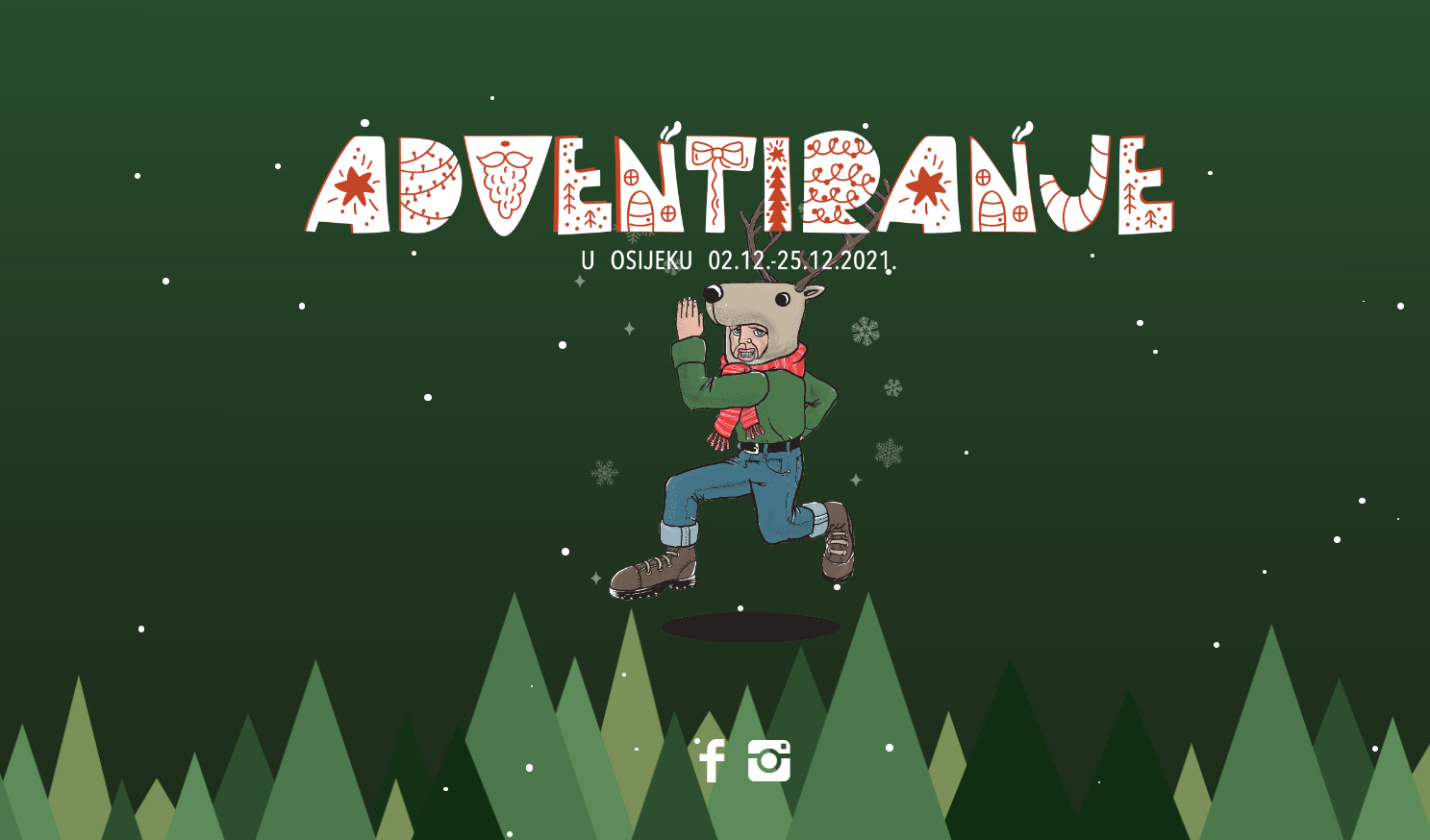
Advent Osijek official website
The long-awaited Adventiranje in Osijek is officially kicking off on the 2nd of December at the beloved Tvrđa location (Osijek historic old town). Events in Tvrđa are always special with the 17th and 18th-centuryth century charm of the old town's streets. Pair that with Christmas decorations and a giant Ferris Wheel, and you've got yourself a perfect little evening of touring the stalls, tasting the sweets, and enjoying the lights and the music. The Advent stalls will be open from 4 pm until 10 pm on working days, while on Fridays and Saturdays, they will remain open until midnight. They will be open from 10 am until 5 pm on Christmas Eve. The Advent programme includes concerts, cooking and wine workshops, seminars, lectures hosted by Osijek's Slavonia and Archaeological museums, and workshops and events for the little ones.
Advent iz Davnina Slavonski Brod
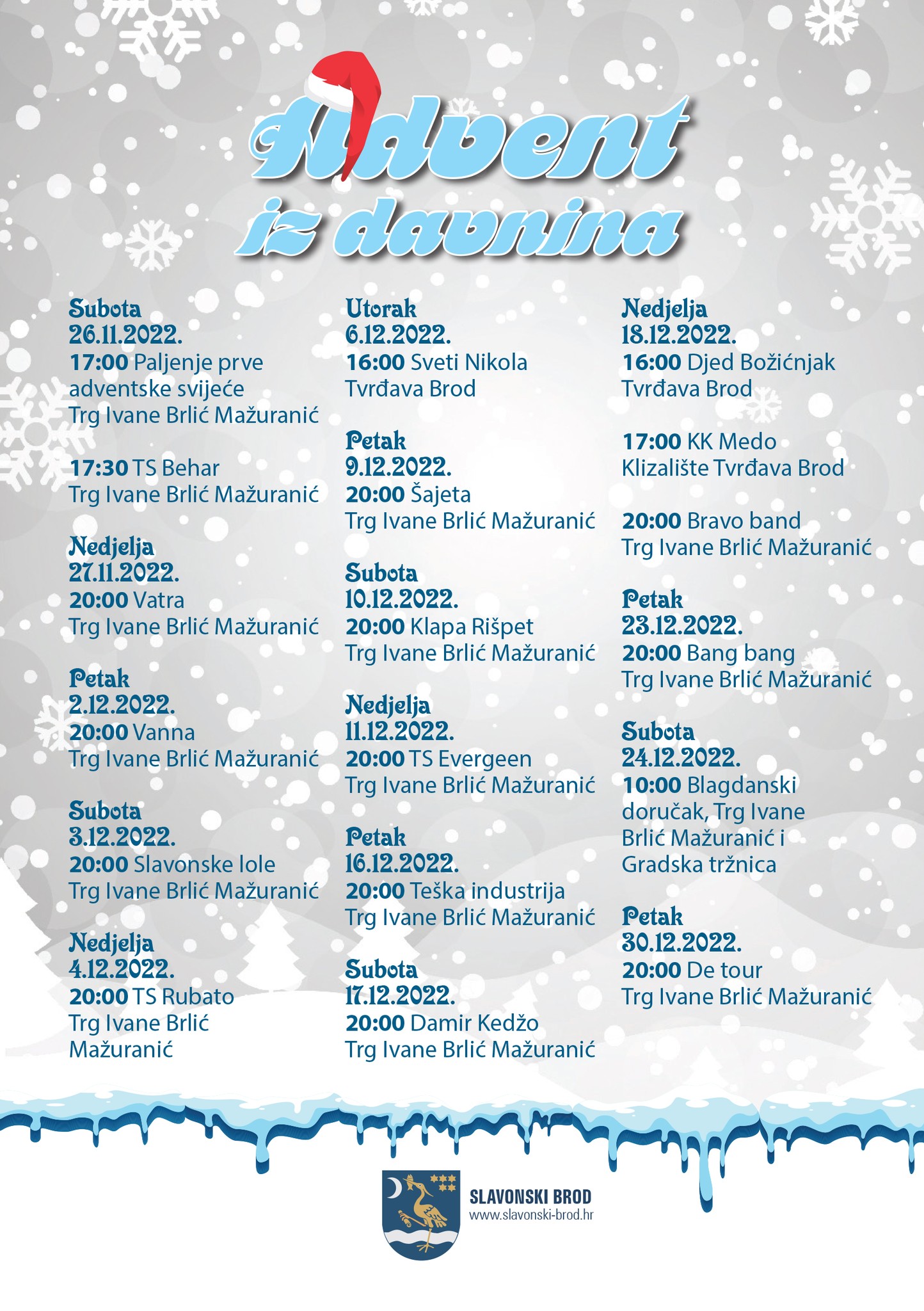
Slavonski Brod official website
The fairytale Advent, inspired by the most famous author of Slavonski Brod, Ivana Brlić-Mažuranić, will this year, too, shine its light and open its pages to all for a magical experience. Voted #4 in Croatia for the year 2021, Slavonski Brod has again prepared an ambitious programme consisting of concerts, theatre, culinary events, and gatherings, ensuring that every Advent weekend is full of fun. The programme started on the 26th of November when the first candle was lit and will continue all the way to the 30th of December.
Advent in Vukovar
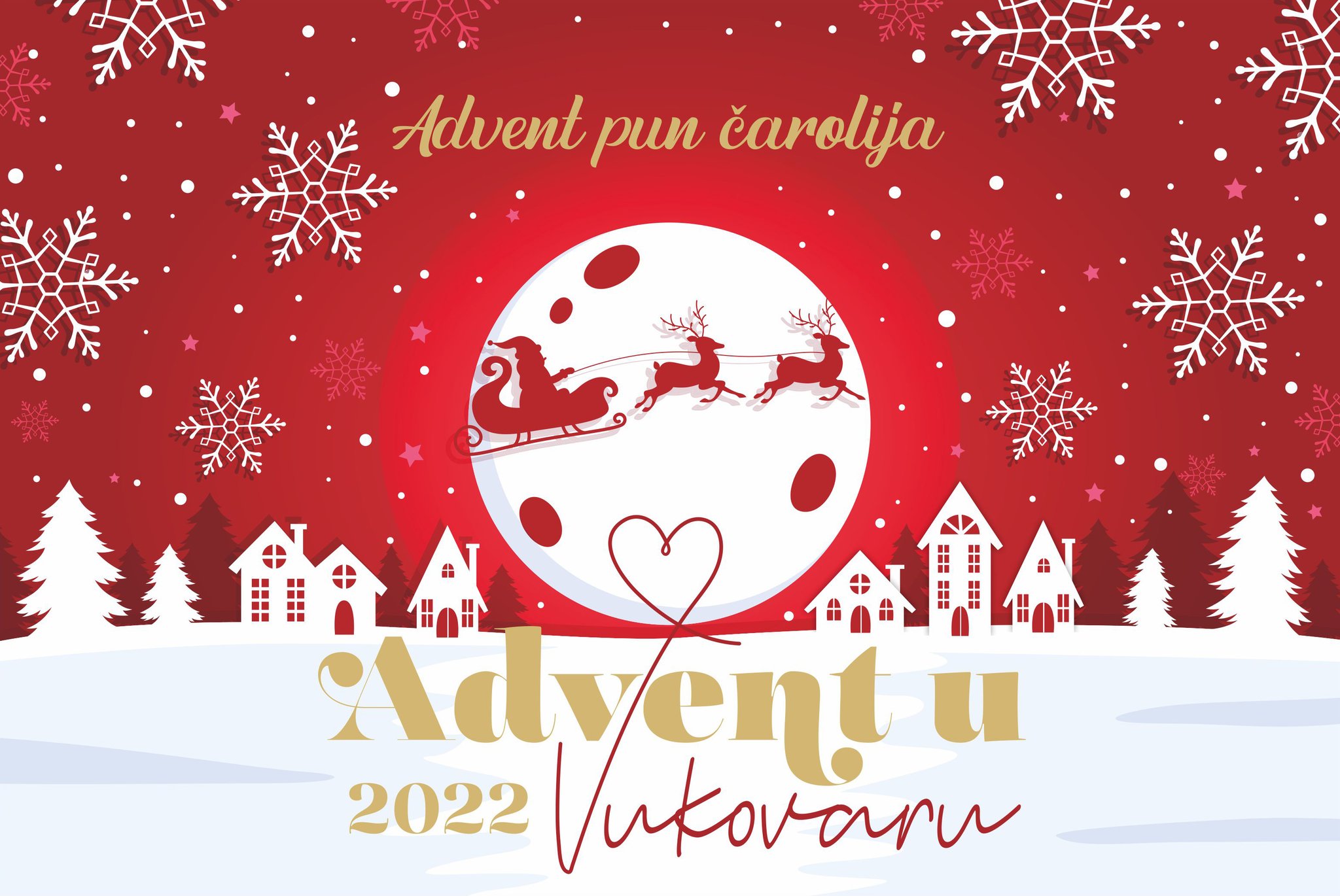
Vukovar Tourist Board
An Advent Full of Magic is this year's slogan for Vukovar. It kicked off on Sunday, the 27th of November when the first candle was lit, and the ice rink was opened. It will go on until the 23rd of December, featuring a variety of music concerts, workshops and events, exhibitions, theatre plays, and a Christmas market. The market will be there on the weekend from the 16th until the 18th of December from 5-7 pm, while on the 23rd, it will be open from 9 am to 12 pm. The ice rink will be open every day from 9 am until 9 pm, while on Fridays and Saturdays, it will remain open until 10 pm. The location of most of the events is the backyard of the Eltz Manor (Vukovar Municipal Museum), and some will take place in the city library.
Advent in Vinkovci

Advent u Vinkovcima Fb Page
The oldest city in Europe also brings an advent full of fun for its residents and visitors alike. Moving from the Korzo promenade, this year's circular ice rink will find itself next to the river Bosut for magnificent views and a truly magical winter atmosphere. It will open on the 9th of December. The Advent Film Tuesdays kick off today, on the 29th of November, at 7 pm at the Joza Ivakić city theatre. The list of films includes The Stolen Princess, Paddington 2, Free Guy, and Arthur Christmas. The entrance is free. Those looking to buy Christmas ornaments or local products or donate to charities can do so every Saturday from 6 pm to 9 pm at the Christmas market in the city centre, where the candles will be lit, followed by concerts. On the 16th of December, the event of the season will take place - the Christmas treasure hunt race. The route is just shy of 2 kilometres and includes challenges, riddles, and tastings of local delicacies. Teams of up to three players can apply. It starts at 6 pm at Franjo Tuđman Square.
Advent in Požega
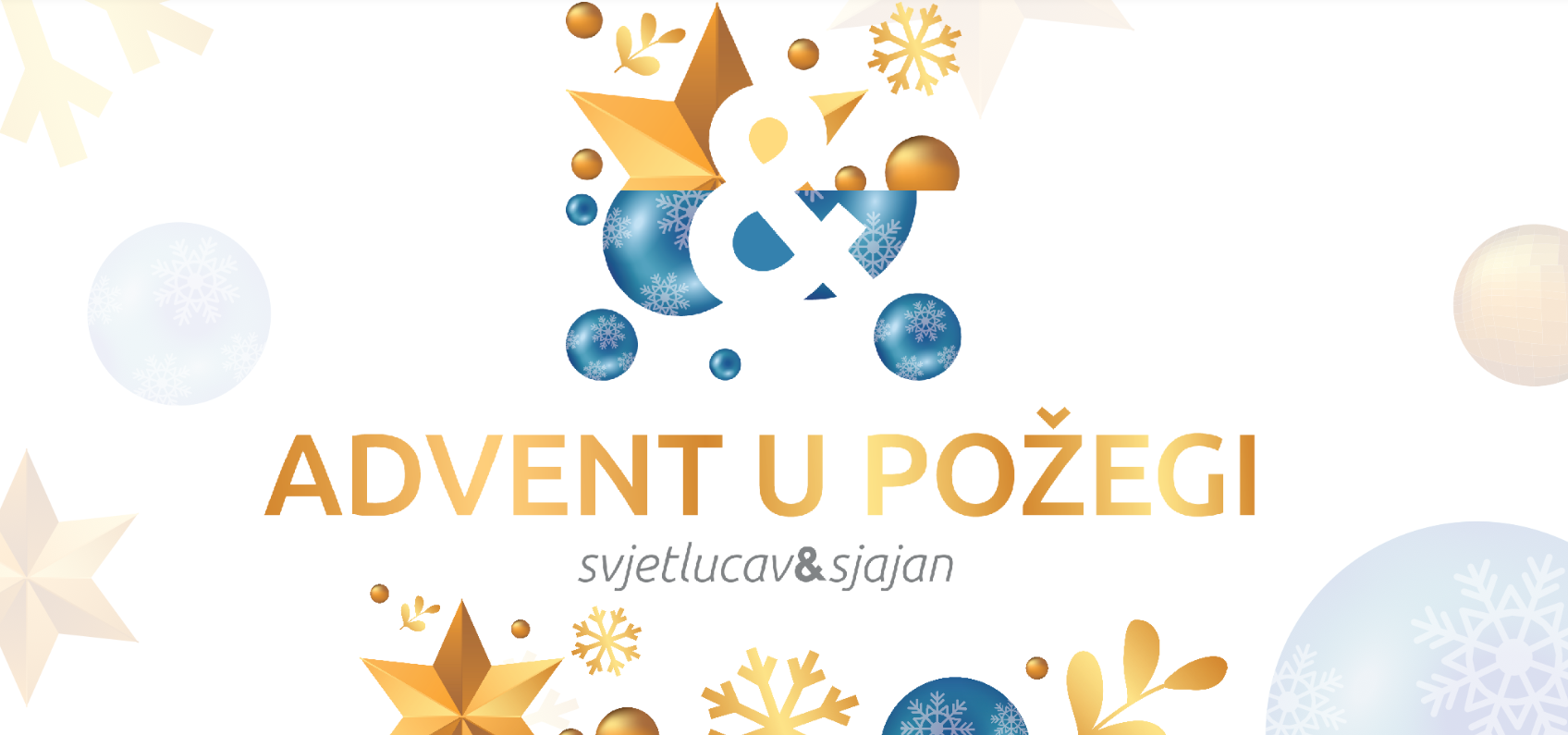
Požega Tourist Board
Sparkly and bright is the slogan of Požega's advent this year. Having unofficially started on the 26th of November when the first candle was lit, the official opening will take place on the 3rd of December with a theatre play, the opening of the ice rink, and a music and dance show. The rich programme will continue until the 31st of December, with the New Year's Party being the final event. This season's events will include movie nights, storytime, concerts, workshops, and many charity events. The city will come together to create a winter wonderland, including its museums, theatres, and schools. The Christmas market will have its stalls set up from the 22-24 of December in the morning hours. And we especially like that there will be a Fitness recovery workshop on the 26th of December.
For more, make sure to check out our dedicated Travel section.
Cvarakfest Karanac: Slavonia and Baranja in a Nutshell
November 25, 2022 - The largest fair of local products in eastern Croatia is held on the Karanac fairground alongside the traditional Cvarakfest. We are yet to find a more Slavonian event.
As SiB writes, like every year, the fattest and tastiest festival in the region awaits on the last Saturday in November. A festival dedicated solely to no less than the truffles of Baranja – cvarci!
The Karanac winter fair is an event that offers the products of almost 80 local producers, mainly from the OPGs of Slavonia and Baranja. Here you can make sure you stock up your pantry shelves for the whole winter. Famous cured meat products from Baranja (kulen, bacon, sausage, ham, cracklings, lard...), wine, brandy, juices, cheeses, pastries, cakes, honey, ground red pepper, wicker baskets, wooden kitchen utensils, souvenirs, antiques, are only some of the things you might find here.
Naturally, no event in Baranja can do without its famous cuisine. At the Vasar (fair), you can taste local cobanac (shepherd's stew), bean stew from a clay pot, kotlovina (grilled meat and vegetable stew), grilled sausages, and carp on forks. Wash it all down with top-quality wine. Before you start, don’t forget your aperitif of homemade rakija!
As part of the Winter Fair, the sensational Cvarakfest is also held in the same place. This unique event is a competition in preparing cvarci (pork cracklings) in the traditional way by “melting” them in a cauldron over an open fire. The winner wins the title of Cvarak Majstor (Cvarak Master). If you don’t feel like you’re up for the competition and would just like a taste, you can buy some fresh hot cvarci directly from the competition cauldrons.
The programme of this year’s Cvarakfest is looking pretty good:
Saturday, November 26, 2022
09:00
- Cvarak cooking competition
- Fair of local products: cured meat, cheese, winter meat, cakes, Baranja gingerbread, rakija, wine, antiques, wooden products, woven baskets, jewellery, souvenirs, etc.
- A rich gastronomic offer: grilled sausages, carp on forks, beans in clay pots, etc.
- Mulled wine
12:00
Cvarak Majstor Award Ceremony
If you are looking to spend the day in nature, with the added benefits of good food and even better fun, trust us – visit the Cvarakfest and winter fair in Karanac. Knowing how things usually unfold in Slavonia and Baranja, you might even learn how to do it and apply for the competition to become the Cvarak Majstor yourself!
And if you’re unsure about indulging in your cvarci as they are, you can always put them away, turn them into drozda and bake them into delicious pogacice sa cvarcima.
For more, make sure to check out our dedicated Travel section.
Wine Tourism in Slavonia and Baranja: Interest Surpassing Capacities
November 17, 2022 - Although wine tourism in Croatia has excellent potential among domestic tourists, and it is a niche that generates great added value and links the development of other segments of the economy, this potential is poorly utilised.
As Poslovni writes, there are no wine hotels, museums, entertainment facilities, or wine roads. However, the interest of potential guests is high, according to an extensive survey conducted by the Improve agency with the consulting firm BlueRock (BRC) this September.
An excellent example of Austria
The research will also be used for the new Strategy for developing wine tourism in Slavonia and Baranja, which BlueRock is working on for the association Graševina Croatica, the largest association of winemakers in Slavonia and Baranja, confirmed Emanuel Tutek, a partner in BRC. "Wine tourism is one of the leading tourist products in Croatia, and at the same time, no Slavonian county has got any strategic document for the development of this product, although the wine business is one of the aggregates for the development of value-added tourism. At the same time, wine tourism is an important lever for the development of winemaking itself and agriculture, as shown by the example of Austria, which successfully connected these two segments, but not without large investments. Wine tourism and winemaking then promote the export component," said Tutek for Poslovni Dnevnik.
Until now, there was no qualitative data on the potential market, i.e., guests who are users or are interested in wine tourism. Of the total number of foreign guest arrivals in Croatia, it is not known precisely how many are wine tourists, that is, those whose primary motive for coming is wine and wine experiences.
There are only estimates for Istria, the leading tourist region with 21.7 million overnight stays in 2021, of which foreign guests make up 85 percent. Istria also has the most developed wine tourism.
It is estimated that wineries in Istria have around 290,000 visitors per year, among whom 30-35% are local, which means that the share of local visitors in Istrian wine tourism is twice that of their share in total arrivals.
BlueRock commissioned research that pointed to additional potential from the domestic guest segment. The study was conducted using an online survey, and respondents were recruited from the ImproveOnline panel.
The research showed 71 percent of respondents were not wine tourists in the last two years. On the other hand, 74 percent of respondents have an interest in wine tourism.
"Therefore, there is a significant market potential that has not yet been used; that is, there is a lack of supply. It is basic, and its development can address potent consumer segments. Visiting wineries is the most common form of wine tourism in Croatia, as are tours of the wine roads. Wine tourism activities, especially with greater added value, such as wine education and workshops, are popular among younger ages (25-34 years) and those with above-average incomes. At the same time, wine events and attractions are better attended in continental Croatia," the analysis states.
The survey also showed that 56% of wine tourists visited the regions of continental Croatia, which is influenced by the proximity of Zagreb. Tutek sees even greater significance in the hilly wine regions north of Zagreb and Slavonia, their current focus.
For the development of wine tourism, the tourist value chain is also necessary, which means that accessibility should be increased, and all necessary infrastructure should be provided, from accommodation, restaurants, museums, and interpretation centers to the development of destination management companies. Tutek notes that this is not the winemaker's job, although it most often boils down to that, as shown by the example of Plešivica near Zagreb.
For more, make sure to check out our dedicated Travel section.
4th, Royal HeadOnEast Festival to Showcase Best of Slavonia and Baranja
September 11, 2022 - Although the east of Croatia lives and breathes hedonism all year round, there is a moment every year when it shines really, really brightly. For the fourth year in a row, during the two-day festival of hedonism, the Osijek-Baranja County Tourist Board will offer to the world the best of Slavonia and Baranja in one place. On September 30 and October 1, HeadOnEast is taking place in Osijek!
As proclaimed by the County Tourist Board, Hedonism is in the east!
The three-day entertainment event, aptly named "HeadOnEast" or simply - Hedonist, invites all pleasure-seekers to head east. You will enjoy, as befits true hedonists, the best that Slavonija and Baranja have to offer.
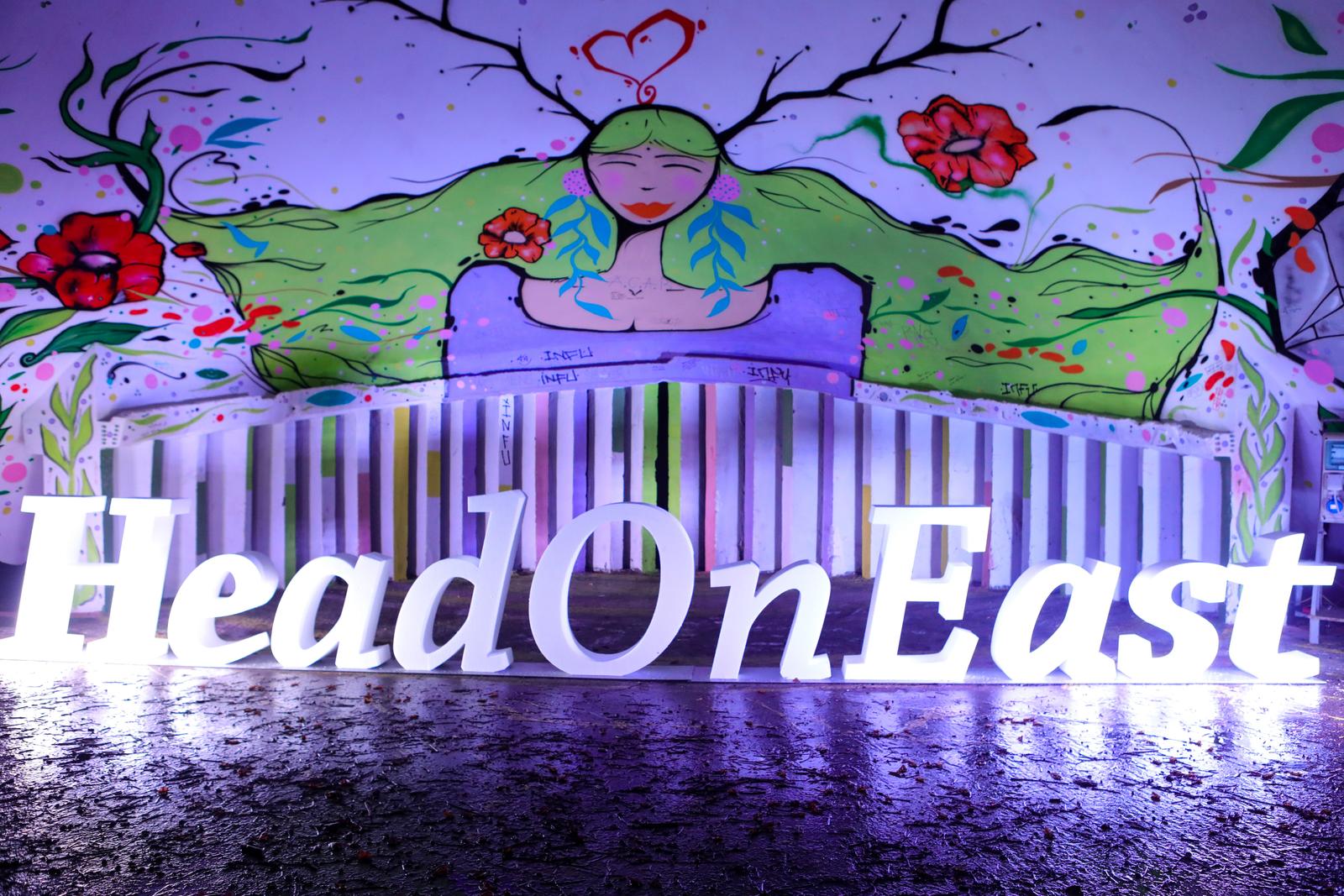
Dubravka Petric / Pixsell
During those days, the old Fortress in Osijek amazes with numerous themed passages and streets, unique content and imaginative activities, along with the smells of the region's best gastronomic delicacies. All this rests on the presentation of the rich offer of Slavonia and Baranja - from well-known events to a diverse cultural offer. Discover how to live hedonism to the fullest and be inspired by the flavours, colours and beauty of this region.
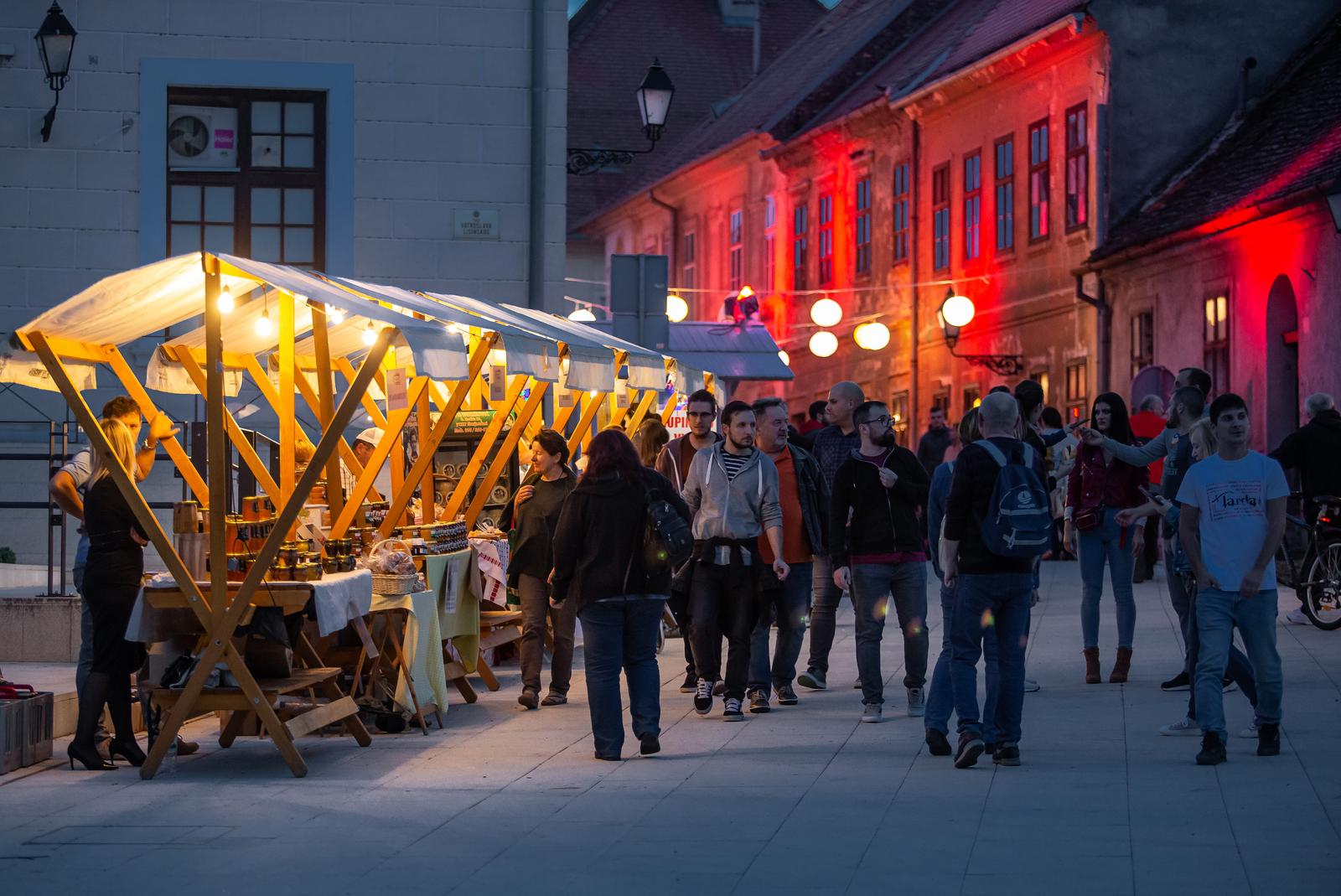
Davor Javorovic / Pixsell
All clear! Hedonists, there is no surrender - except surrender to pleasure.
This year, it carries the "royal" title because the main program will take place in the parks of King Petar Krešimir IV and King Tomislav. In addition to the art of light, the mandatory parts of this year's HeadOnEast traditionally include other types of art, wine, beer and all kinds of gastronomic delicacies. An excellent music line-up will be in charge of spicing it all up. This year's list of hedonists includes Fluentes, Gelato Sisters, Z++, Massimo, Daleka Obala.
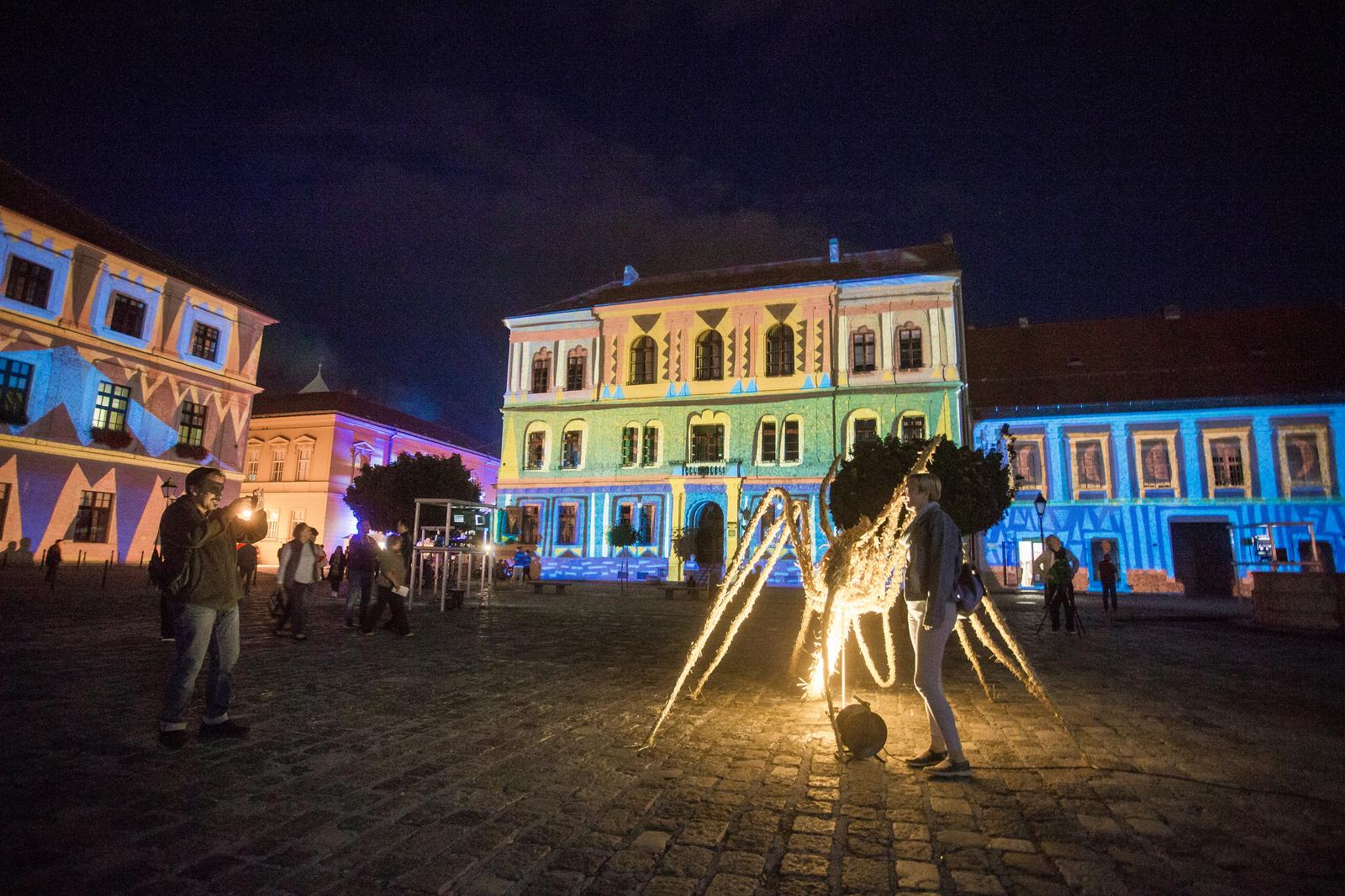
Davor Javorovic / Pixsell
Up to date information about the event and the program can be followed in detail at visitslavoniabaranja.com, Facebook page Visit Slavonija Baranja and Instagram profile visit.slavonija.baranja.
For more, make sure to check out our dedicated Lifestyle section.
Season 2022, Mission Year-Round Tourism: Vukovar Well on the Way
September 8, 2022 – While the Adriatic coast is still almost exclusively a summer destination, other parts of Croatia strive to fill the gap. Among them, Vukovar is indeed full of life, 365 days a year. The local tourist board shared some of their insight for season 2022 so far. Year-round tourism in Vukovar is the mission, and it seems that it’s been going well.
CNTB has been working to stregthen continental tourism, and Vukovar is a step ahead. As they put it in the local tourist board, this city is not a seasonal destination anyway, though its highlights are a higher number of tourist arrivals in spring and autumn. Statistically speaking, the number of overnight stays is an indicator of the success of a season, but in Vukovar, even one-day visitors should make the count, it's just that it is difficult to count them accurately.
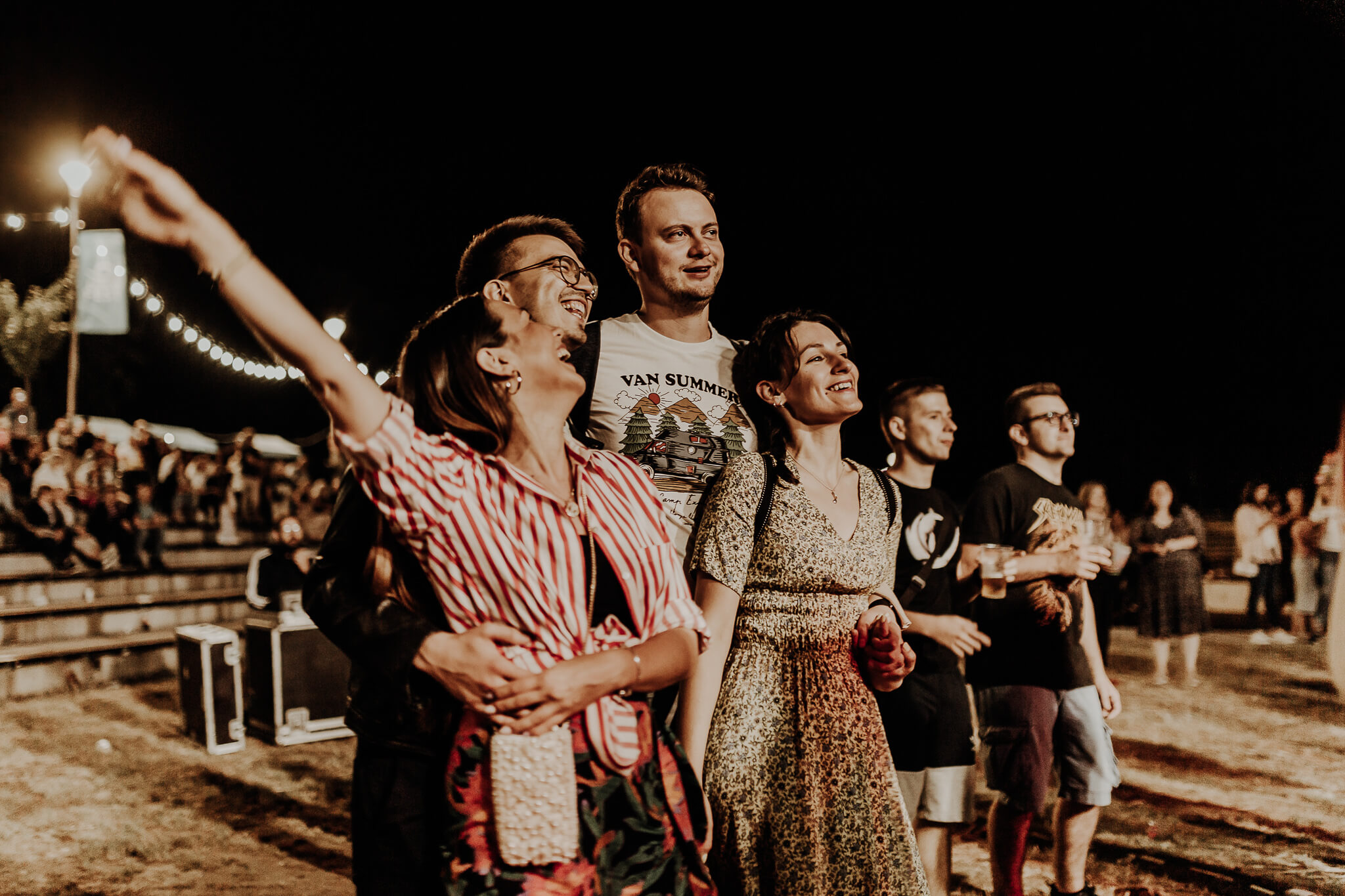
Significant sports events as well as manifestations and festivals generate an increased number of arrivals and overnight stays (Vukovar Film Festival, Svi zaJedno Hrvatsko NAJ).
In the period from 1st January until 31st August, 19.605 arrivals and 33.005 overnight stays were recorded in Vukovar. Out of the total number of overnight stays, 24.641 were domestic guests and 8.364 foreigners. The number of overnight stays compared to the same period last year is 113.93% higher in total. The number of overnight stays of foreign tourists increased by 63.26%, and of domestic tourists by 139.12%. Such a large overnight index of domestic tourists is the result of the return of students' visits for a two-day tour of Vukovar, while in 2021 they would only come for one-day visits, without overnight stays.
As for arrivals, the total amounts to 19.605, of which 2.744 were foreign guests, and 16.861 were domestic. Last year, there were 13.756 fewer arrivals, because in 2021 there were no student excursions that included overnight stays, so they are not recorded here. Looking at arrivals and overnight stays in 2022 without students, the total number of arrivals was 9.188, of which 2.725 were foreign guests and 6.463 domestic. This means that this year 10.398 students visited Vukovar. Comparing the indexes of arrivals and overnight stays, it is apparent that in the total amount, arrivals exceeded last years' by 57.9%, and overnight stays by 36.60%. The number of foreign tourist arrivals increased by 97.89% and domestic by 44.52%. In terms of overnight stays, the increase of foreign guests has been 61.59 %, and domestic guests 24.18 %.
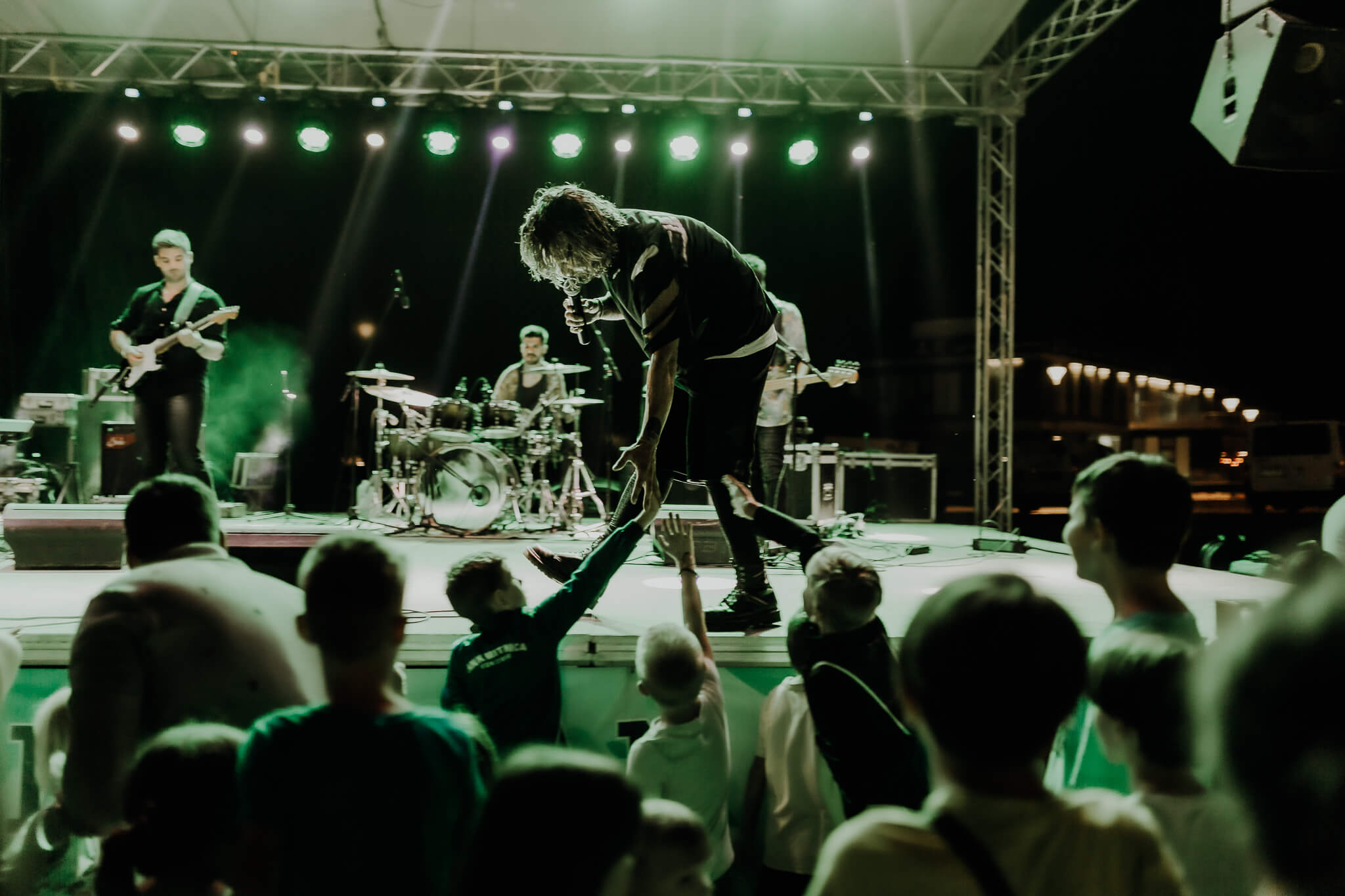
The people of Vukovar have always lived on and by their river, and they still spend a lot of time on its waves and banks. It is increasingly attractive to guests from other parts of Croatia, and numerous guests from all over the world on river cruises sail down the Danube.
In 2021, 125 river cruise ships docked in Vukovar with 11.349 passengers. For 2022, 339 cruisers were announced, at the level of 2019, when 351 cruisers docked.
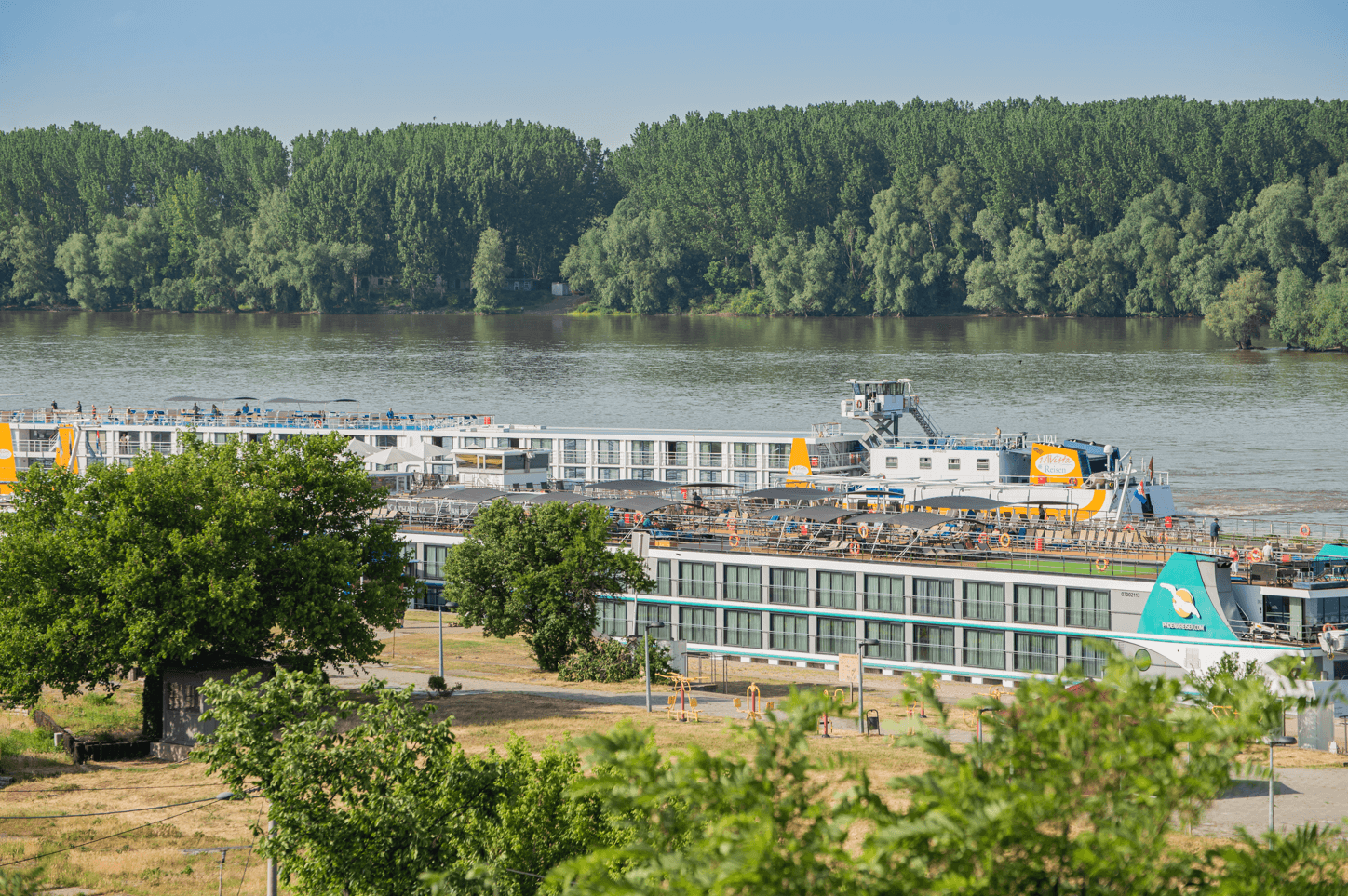
The Film Festival of the Danube countries - the Vukovar Film Festival, which is in many respects unique - has returned to the banks of the Danube in its full glory. It is the only film festival that literally takes place on the Danube and thus offers a unique experience. It was designed to promote and expand the creative rise of filmmakers from the Danube countries. The 16th edition of the Festival was held from June 29 to July 3, and it brought over 50 of the latest acclaimed and award-winning films from prestigious international film festivals.
Vukovar was an important destination for film festivals this summer. Another film festival premiered on July 29 and 30 - Klein Film Festival. Klein is a film and music festival, which is conceived as an international festival of short feature, documentary, and animated films up to 20 minutes long. The festival is a tribute to Hugo Klein, a theater professor, theoretician, and psychiatrist born in Vukovar.
Summer in Vukovar is unthinkable without swimming in the Danube on Vukovar Ada, a sandy island opposite the city that is ranked among the ten most beautiful and interesting beaches in Croatia on rivers and lakes. This year too, free transportation was provided for all those looking for refreshment and an escape from the heat and scorching city asphalt. The Vukovar Ada is a great place for camping and beach volleyball, and good fun in a pleasant company is guaranteed.
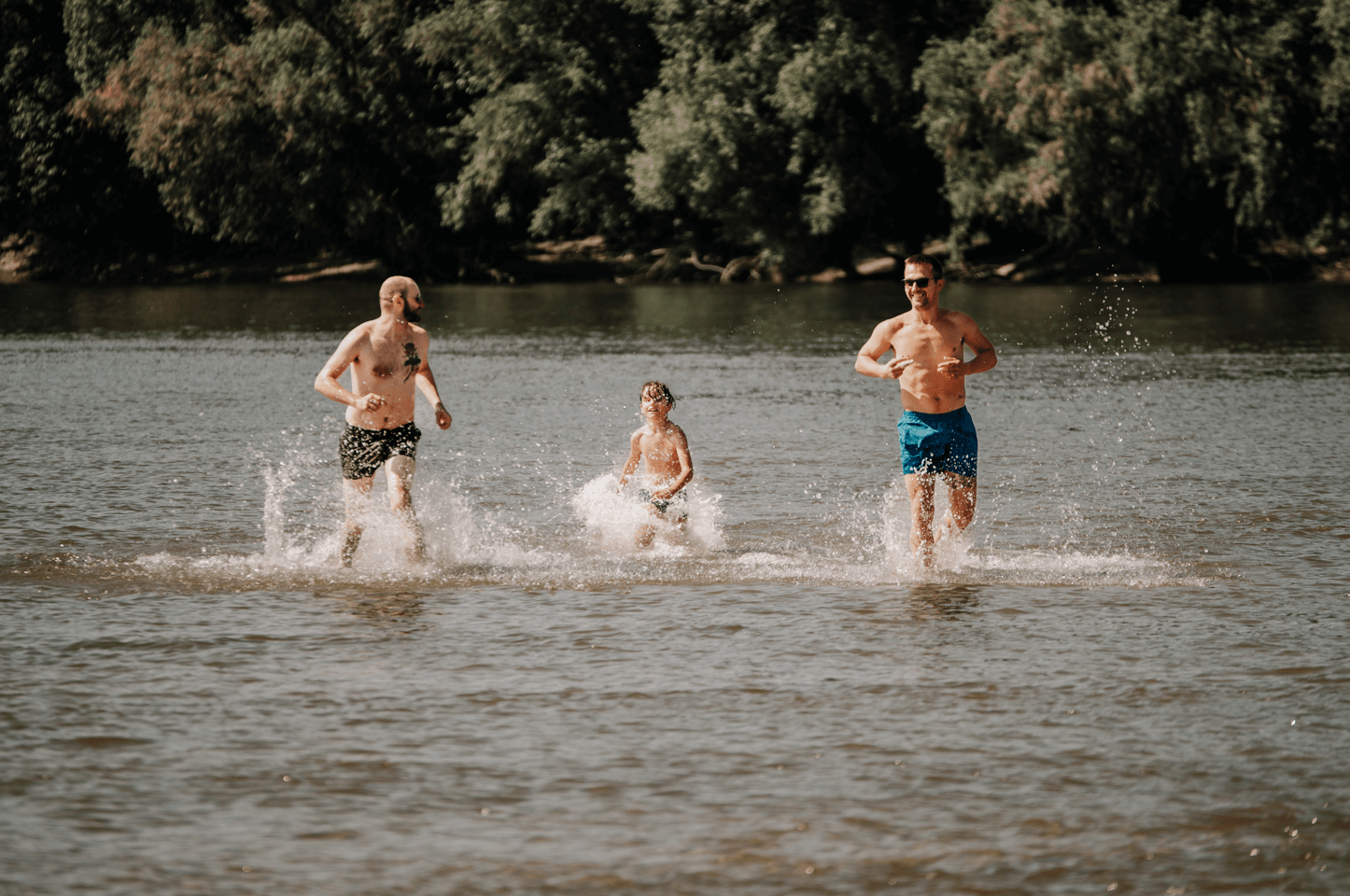
An interesting program called Danube Garden Summer Nights has been designed for this year, with good music, delicious food, and refreshing drinks under the Danube stars. A total of four concerts during July and August were held on the summer stage by the Danube, which in its magical ambiance was a hit place this year for pleasant socialising, fun, and enjoying the beauty of Vukovar nights. There was also a cinema under the stars, a motorcycle party, and numerous other cultural and similar events. It is no small thing to live in a city through which the second largest European river flows! It should be emphasised, celebrated, and simply lived with the Danube, as the people of Vukovar show by example.
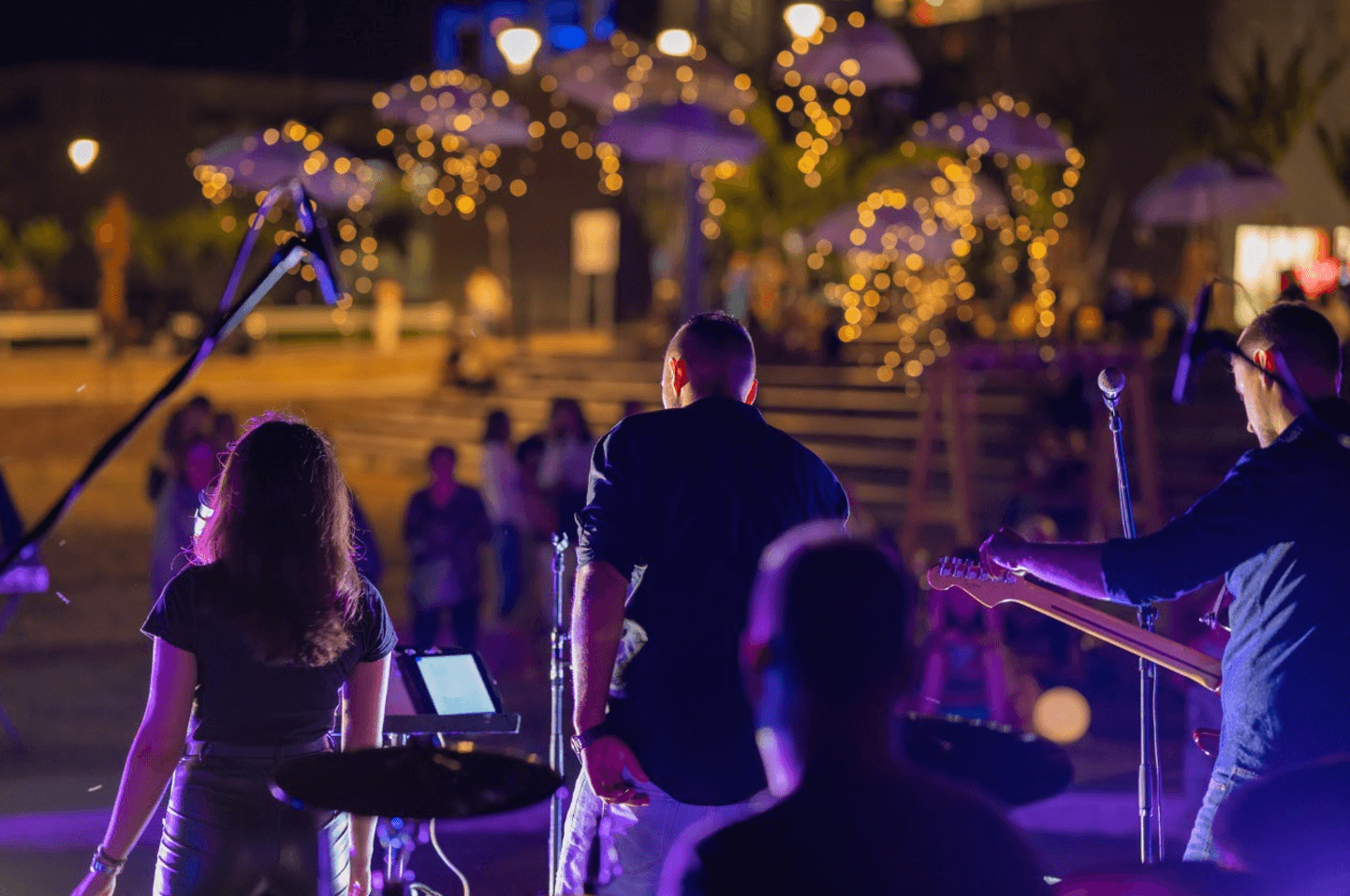
As autumn approaches, preparations begin for the 15th Vukovar ethno fair, which will be held from September 23 to 25 at Republic Square. Craftsmen from all over Croatia will join the fair again this year at the 6th Flavours of Croatia fair, organised by the Vukovar Artisans Association, where they will prepare and present their autochthonous dishes. Brewers and representatives of the German and Austrian minority communities as part of the 5th Vukovar OktoBierFest will also showcase their products. There is no better place to promote beer and brewers than Vukovar and its fair - after all, the first beer was produced in Vučedol.
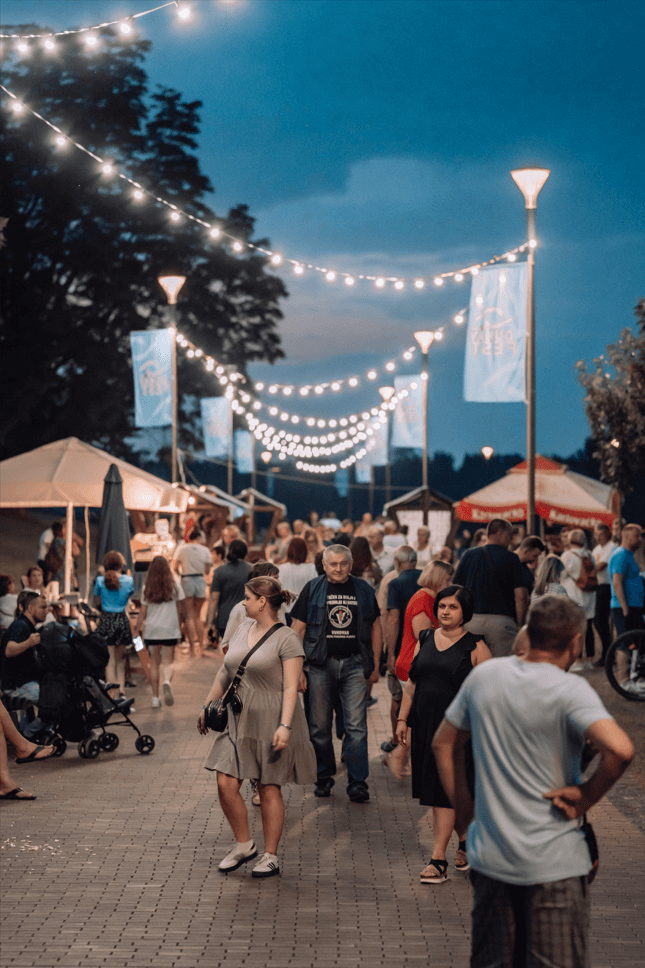
During the fair, the Association of Tourist Guides of the City of Vukovar is organising a free guided tour of the city for the local population and visitors for the fifth year in a row, on the occasion of World Tourism Day, which is September 27. This year, costumed guides will take us back to the old times in the city.
All photos by Vukovar Tourist Board.
For more, make sure to check out our dedicated Travel section.
Osijek Software City - Best Place on the Planet for Family Life
August 24, 2022 - Nathan arrived in Osijek from Arizona via Colorado and Prague. Not only did he find a job there, but also what he calls the ideal place for family life. The Osijek Software City movement is slowly, but surely coming to life.
As RTL writes, Osijek is a city where IT companies produce good software. Where do you acquire the necessary knowledge and skills for that? Where are the educated and motivated workers employed in quality and promising companies? This is how the objectives of the Osijek Software City project were presented, were they achieved?
Ten years from the first vision of Osijek as a regional IT center, and seven years until the first company in the IT park. The story of Osijek Software City unfolded slowly.
“It went slowly and it was difficult, but now it's going faster and faster”, Denis, one of the initiators of this story, told RTL. Better cooperation with universities will create the necessary IT specialists and scholarship programs with the City and the County that will attract young people.
“For us, this current pool of young people is no longer enough to turn Osijek into a true center of the IT industry, and we will really need to attract and import a lot of foreign students”, says Denis Sušac, director of the IT company.
Nathan arrived in Osijek from Arizona via Colorado and Prague. Not only did he find a job there, but also what he calls the ideal place for family life.
“Osijek could be one of the best cities on the planet for family life”, said Nathan Chappell, a developer.
The family spirit is present in the workplace, and his family is also helping him learn the Croatian language.
Ivana, on the other hand, studied languages, but after finishing her studies, she felt that it was not her life's calling.
“And then, little by little, I started poking around in IT to see what was there and what I was really interested in and I came across this testing”, said Ivana Belak, software tester.
She didn't want to leave Croatia and rather wanted to find the job she desired here, and that, she says, came true.
“We think that today young people can live very well working in Osijek, without leaving, and this trend of going to Ireland, Sweden, Germany is slowly coming to a halt”, claims Sušac.
The number of IT people in Osijek is growing. The goal of recognising Osijek as a city where IT experts live and work is becoming closer, and without their skills life is almost unimaginable today.
For more, make sure to check out our dedicated Lifestyle section.
Discover the Croatian Danube: Fishing Village of Aljmaš (part 2)
August 21, 2022 – In TCN’s new series, Discover the Croatian Danube, we explore the little villages that lie on the banks of this mighty river. We started from the point where the river Drava “surrounds its water and name to the Danube”, in a small fishing village called Aljmaš. If anything, you might know that Aljmaš is a Marian shrine with a big modern church and that it’s somewhere in Slavonia (could be Baranja?). There is a lot more to these few streets that make the village. A very long and rich history in a geographically important and interesting position. Legends, traditions, and stories of hardship, friendship, and mischief. Learn about the former in Aljmaš part one and buckle up for the latter in the following paragraphs.
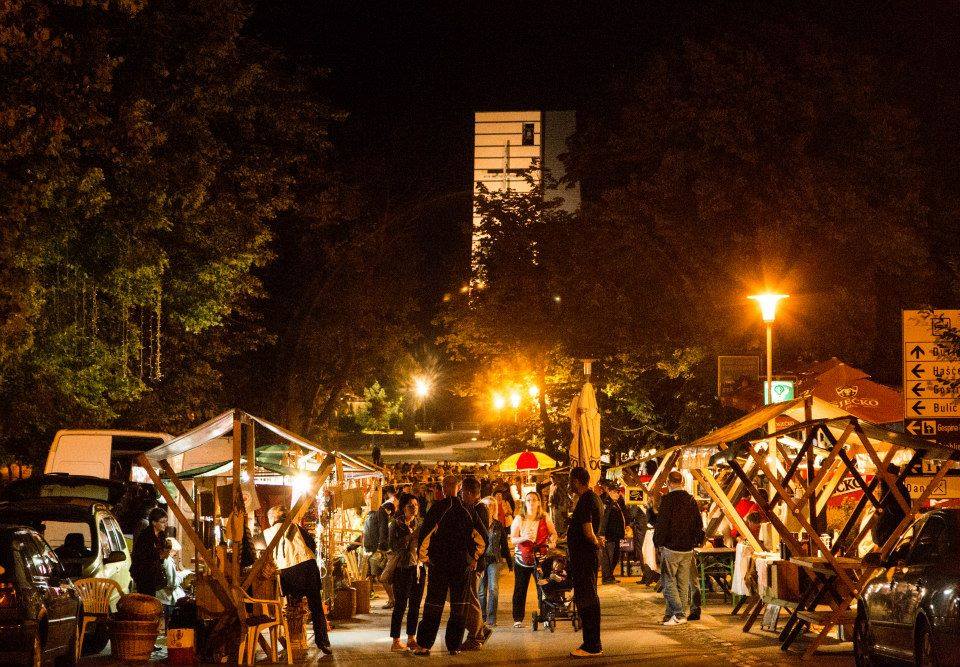
Photo: Aljmaška ribarska noć
Every village has its traditions. They are usually tied to the big holidays or otherwise important events, serve to bring people together, and are overseen by village Google. If you don’t know about the phenomenon, just ask any local grandmother about current events. In Aljmaš, its geography was used to make sure that things run smoothly. Before the modernisation of the infrastructure which took place in the 2000s, there were three canals for the rainwater to drain into the Danube. The embankments were used for social purposes where boys would gather and hang out on one, girls would do the same on another, and the third, you guessed it, was reserved for the smooth running of surveillance.
Other events couldn’t do without it, either. One of them was something called lelujle. In the spring, on Palm Sunday, there was a tradition for the ladies to let their romantic interests know who they were. This was, of course, done using old pots and pans which the girls would throw over the gates of their hopefully future husbands. This all gave the security something to do, as they would have to be the ones to either prevent the accumulation of unwanted old pottery or clear it out afterward. Usually with the words “better take this rubbish back to your mother’s house”.
The final quirky tradition presented here, and the author’s favourite is called buše. It occurs as the accompanying content, or the entertainment to go with the hard work that is the winter preparation of pig meat traditional for Slavonia. To lighten the mood, it was the task of a volunteer trickster to manage mischief. The primary goal was to play a trick on the host and acquire as much meat and snacks as possible, all while making sure that your identity remained completely hidden. Among other things, wine barrels were used to that end. The loot would then be served at a party.
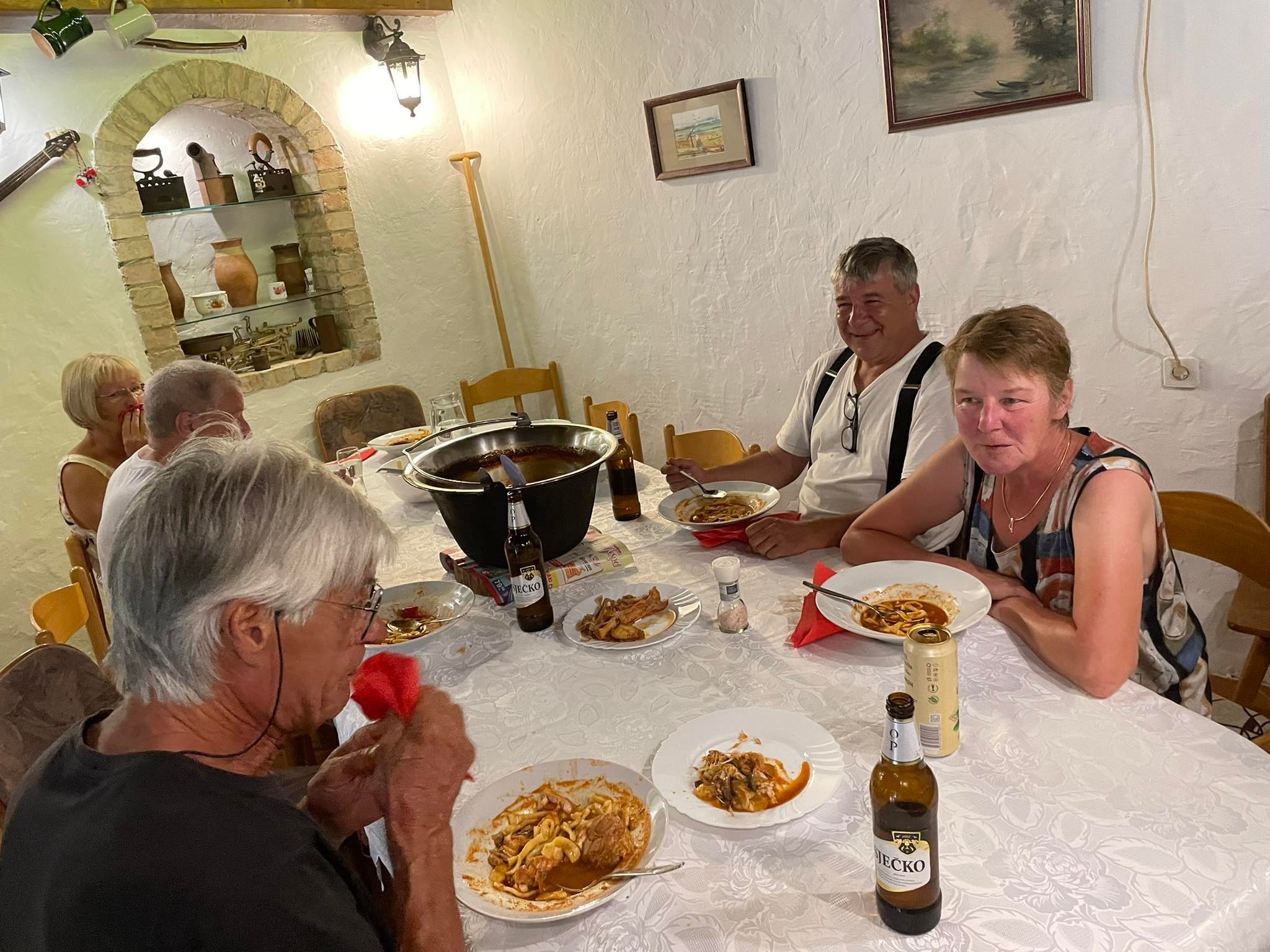
German fishing crew enjoying a delicious dinner
The Danube is the heart of Aljmaš. Fishing, camping, and picnics on the riverbanks are a way of life. Naturally, one of the most important local dishes is fish stew. This delicious, hearty meal is usually made with carp, catfish, pike, or a combination of those, over an open fire in a hanging pot, with an addition of smoked sweet and spicy paprika, onions, and wine. The ingredients can vary, and every good cook will keep their secret, but one thing is sure – love is always the primary spice. And Aljmaš breathes love for the river, for food, for good company, and a good time. A true testament to this is the annual Aljmaš Fishing Night. It was born spontaneously out of a night of good fun, cooking and a friendly cook-off between Dalmatian cooks with fish from the Adriatic Sea and local cooks with Danube fish. The eighth Aljmaš Fishing Night held in 2019 hosted over 8000 visitors who all cooked, ate, sang, and danced all night long. Unfortunately, due to the pandemic, the festival was put on temporary hold, but the organisers cannot wait to be back and have already started planning Fishing Night 2023. A little fishy told us it might be the biggest and best one yet. It is usually held in late May or early June. For more info, to get a feel of the atmosphere, and to make sure you don’t miss the next one, follow Aljmaška ribarska noć on Facebook.
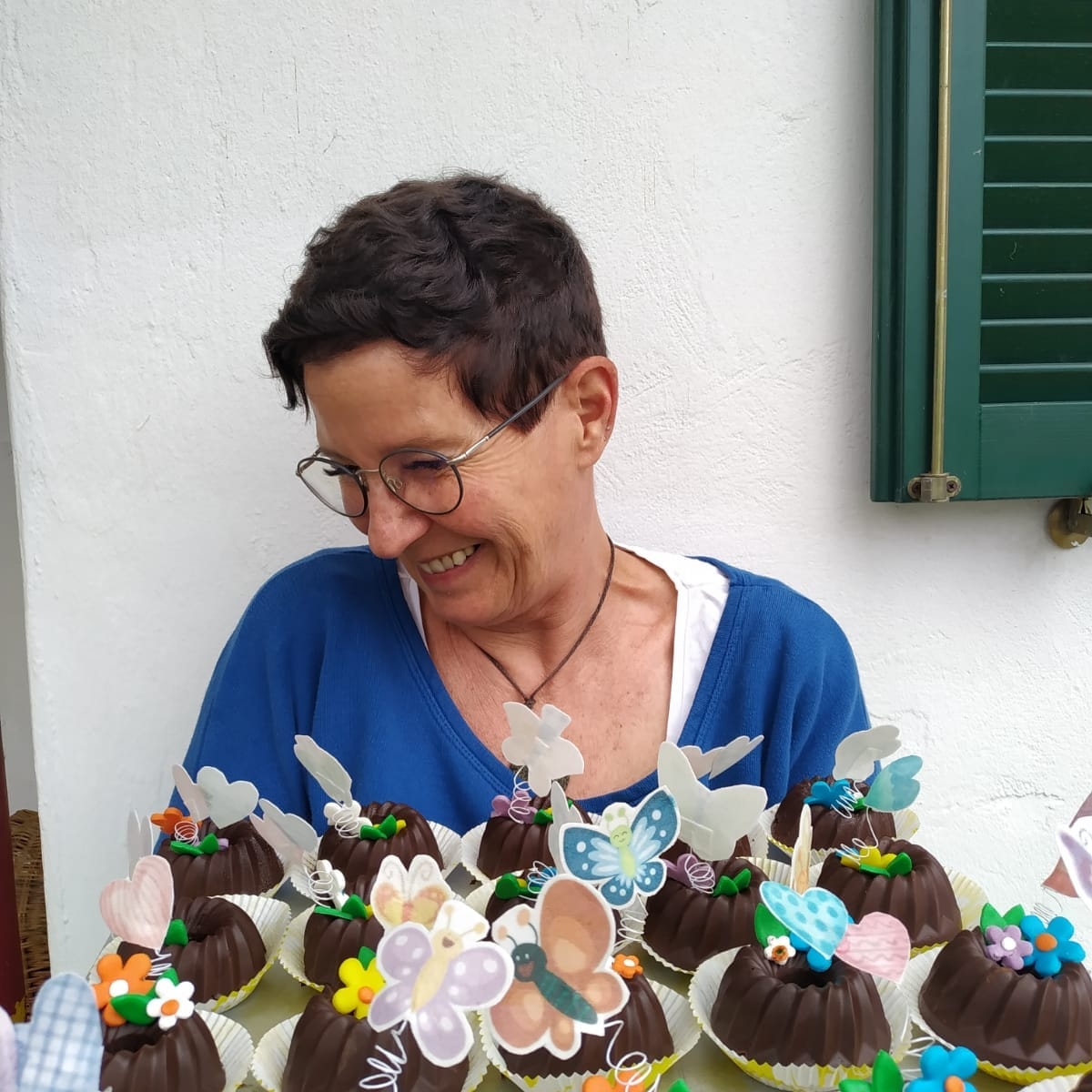
Photo: Susi Petrijevčanin
The driving force of the events, traditions, and all other ways in which Aljmaš lives, is of course its residents. There might not be many, but they are the most generous and friendly bunch. Not only will they greet you with a smile, but they will also host you, show you around and feed you. One of them is Susi Petrijevčanin, a German nurse who decided to move to Aljmaš for love, the fresh air, and the perfect lifestyle. In her words, it’s a place where you can let your child go outside to play all day. They might come back muddy, tired, knees scraped, but they’ll always be happy and healthy. To ensure that a lunch of delicious fish stew is followed by lovely desserts, Susi has opened her dessert shop in Aljmaš, which you can follow here.
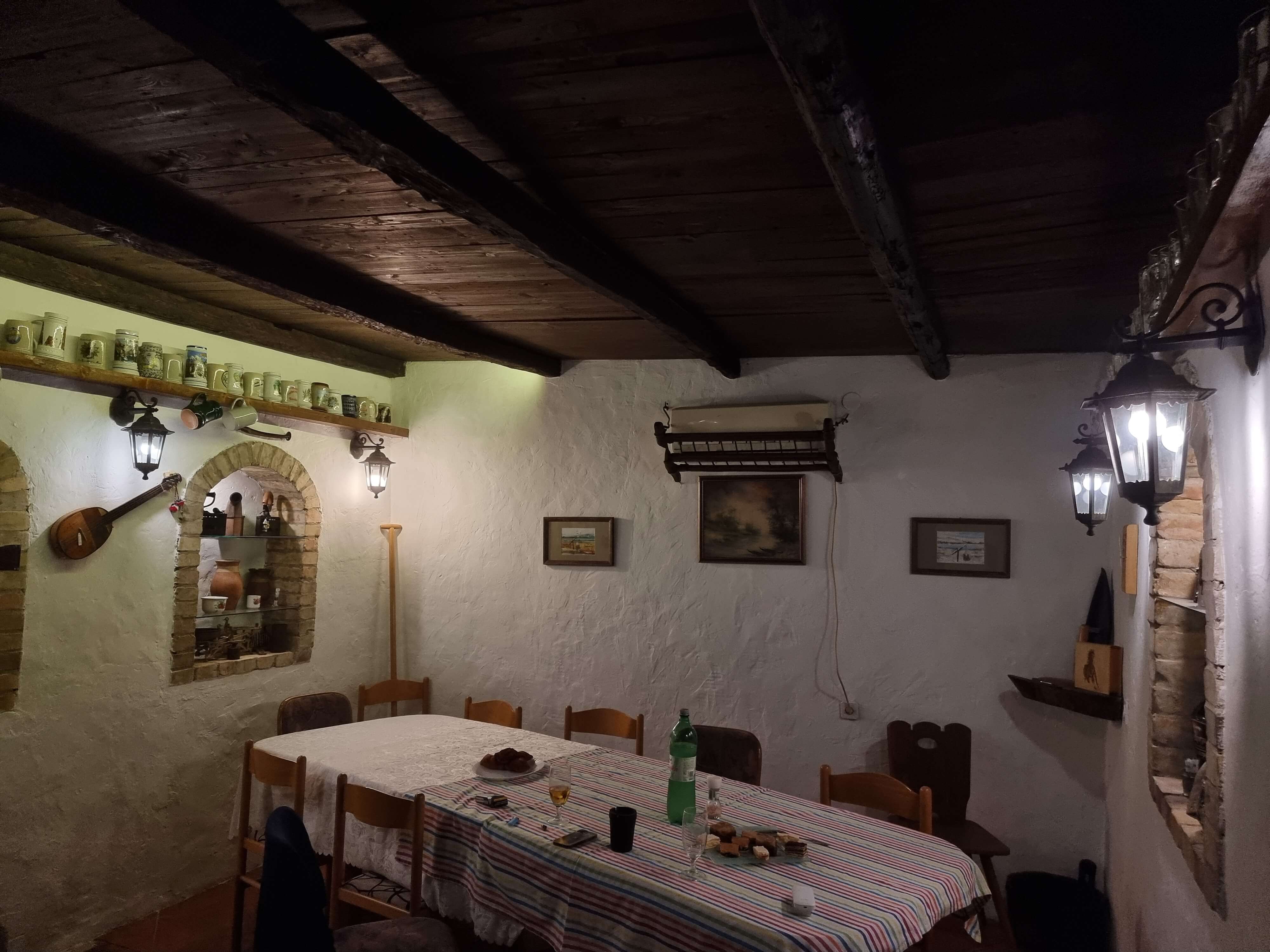
If any of this inspires you to visit Aljmaš, we encourage you to do it yesterday! Our guide Marina will be more than happy to help and will ensure that you have the best time. She will tell you a story or two about the village, her family who has lived in Aljmaš for five generations and might be traced back to Napoleon Bonaparte, as well as what the best ways are to catch and prepare fresh Danube fish. If she likes you, she might even show you her house which has stood in the village since before the 1900s. Whether it’s the original bricks, wooden structure, or the wine in the cellar, there is an incredibly special feel to the place.
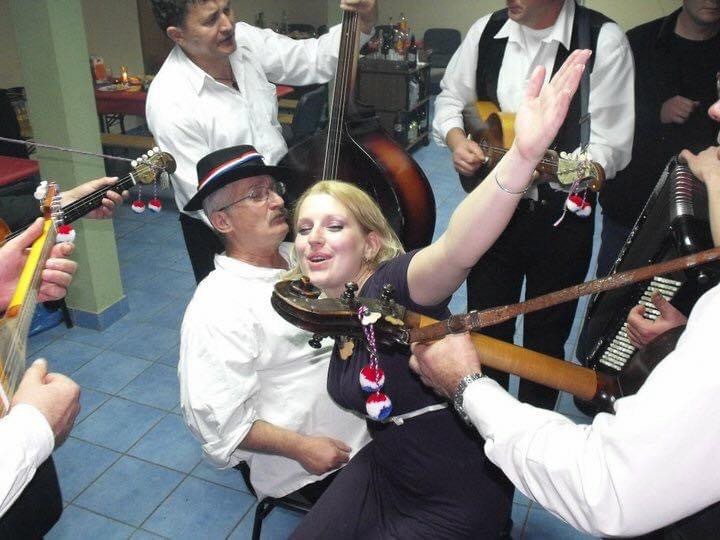
Marina with her father in traditional wear. Standard atmosphere in the village.
If you would like to contact Marina and plan your visit, email TCN This email address is being protected from spambots. You need JavaScript enabled to view it., Subject Aljmas.
How good is your knowledge of eastern Croatia? Take the CROMADS test above - how many places do you recognise?
For more, make sure to check out our dedicated Travel section.
Rent a What in Slavonia? Rental Cars Nowhere to be Found
August 12, 2022 - Picture this. It's August, you've arrived in Croatia, planning to take a casual trip to Slavonia, you'll rent a car and chill it out, no problem... The only thing is, rent a what? Cars are fully booked out in Slavonia.
The news that it is currently impossible to rent a car in Osijek sounded a bit unreal, comments Glas Slavonije. Searching the internet for car rental places, judging by the number of ads, made it all seem a little suspicious. Additionally, there are numerous intermediary sites where you can find rental cars for any date up to mid-September without a problem. GS decided to do some research and called a rent-a-car in Osijek.
“Unfortunately, we do not have any available cars for rent in Osijek. In the last two years, we have never had such a demand for our services. Summer always stands out, many tourists come, rent cars, and take it to the coast, but this year we have been booked non-stop since the beginning of June. In the meantime, gaps are created when the cars are returned which must be taken back to Osijek and are rented out again very quickly. The prices are around HRK 300 per day, and of course, the longer the vehicle is rented, the lower the price. The same happens every summer because of the season, but you could always find a vehicle to rent here, until this year”, Petar Kontić from Currs d.o.o. told GS.
Despite the ever-improving tourism results, Osijek is still somewhere on the sidelines when it comes to air traffic. Tourists come to Osijek either in organized tourist arrangements or by car, so the demand for the rent-a-car service has decreased. However, an additional problem for the car rental market is the overall market situation, as car production has stopped.
“The situation is such that there are simply no cars on the market. Due to the lack of chips, production stopped, and considering that we renewed the vehicle fleet every year, we were not able to buy new vehicles, but we stayed with the number of cars we had the previous year. Summer is the peak season for everyone who rents a car, there is more travel, and foreigners come to us to rent a car immediately after arriving at the airport. Most of the vehicles are in the places where the number of arrivals is the highest, i.e. Pula, Split and of course, Zagreb. People couldn't wait for all bans to be lifted due to the pandemic, so this year the demand for our service reached its peak. Our prices start from HRK 200 a day”, points out Manuel Šimić from Carwiz.
And Davor Šimara from Nippon confirms that this summer season is truly special, that there is great interest in car rental services, so it is almost impossible to find a free car that could be rented for a long time, but only for a day or two, between two pre-booked appointments.
In the end, of all the companies contacted in Osijek-Baranja county, available vehicles were only found in Sixt, the largest rent-a-car company in Croatia. They had three free vehicles around Osijek. They also noticed a significant increase in the use of their services this year.
At Aurelia Vinkovci rent-a-car, it was confirmed that this season was their best so far, and they have been in this business for five years. As Luka Janković, director and owner said, they have 30 vehicles at their disposal and those who need a car rental service should contact them and agree on the type of car they need, as well as the exact date or period for which they want to rent a car.
“There is always something available, but we need to know the date and what type of vehicle they want since our vehicles range from high class to luxury class. The demand has been high this summer, because, after the pandemic, people started coming not only from European countries, but also from Australia and America, so in the period from June 15 to September 15, we had many booked vehicles”, said Janković.
As for the prices, he emphasized that they have new vehicles, up to three years old, and the prices, depending on the type, range from the most affordable Volkswagen for HRK 250 to a Jeep that goes for HRK 700 per day.
“We offer a wide range of vehicles, with the highest demand in the summer season and the winter, around Christmas, when a lot of people come to Croatia for the holidays. For those flying into Osijek and Tuzla, we deliver vehicles to the airport, as well as to home addresses. Those who come from distant countries know that it is more convenient for them to take a completely safe and insured car while they are in Croatia than to drive their car more than a thousand kilometers and pay for fuel for such a long trip” emphasized Janković.
GS also asked about the issue in rent-a-car companies in other parts of Slavonia and Baranja. In the Vukovar company VU RENT d.o.o., they experienced the same problem, where they told GS that every summer is the same story, the arrival of tourists always means more rented vehicles, but this season they have had the highest interest since they have been in business, and everything started from Easter. On the other hand, the company Rent E Car from Đakovo does not have such a problem, because they prepared in time for the summer tourist season, and they also offer electric vehicles.
For more, make sure to check out our dedicated Lifestyle section.
OPG Čudesna šuma: Paradise Reimagined in Beautiful, Traditional Baranja
May 13, 2021 – OPG Čudesna šuma: How an unexpected turn of events helped world-renowned photographer Mario Romulić realise his lifelong dream.
War and genocide and the aftermath. Famine. Disease. Death. In a former life, harrowing images filled the lens of internationally renowned photographer Mario Romulić. But thankfully, we're now far from such scenes.
In fact, at OPG Čudesna šuma - Mario Romulić's home and family farm - we're pretty much far from everything. One other eco-farm is his only neighbour. Well, unless you count the llamas the Romulić family keep out back. Occasionally, through the rich green of surrounding trees, you see birds flying above the branches. Probably they're toing and froing from Kopački rit. The nearby Nature Park is less than a kilometre from OPG Čudesna šuma. Famously, the wetlands are home to over 250 species of birds. They are also the reason why Mario Romulić is here.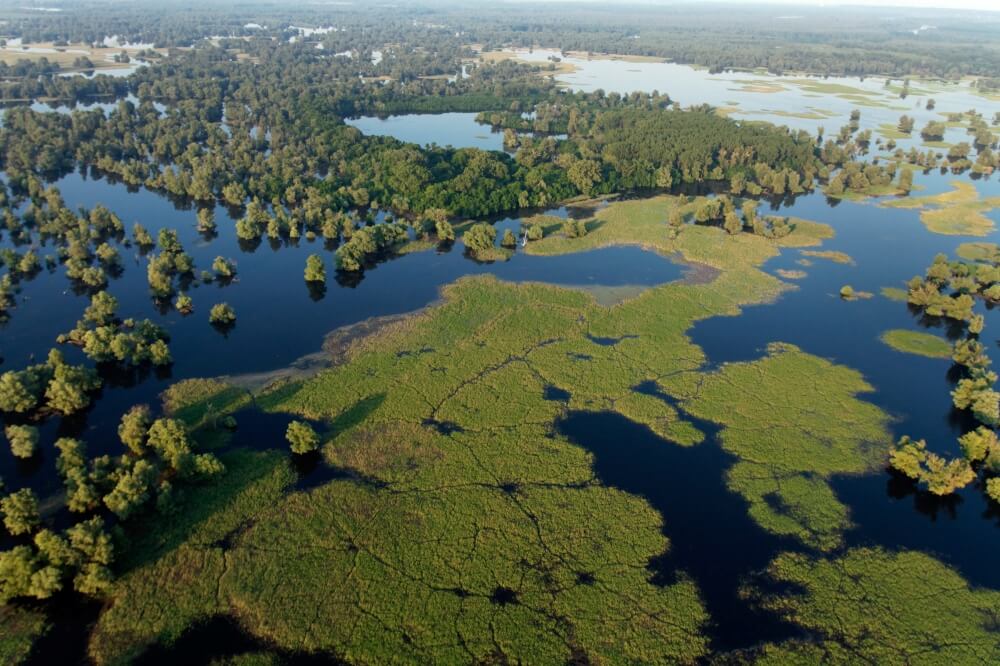 Kopački rit Nature Park © Kopački rit Nature Park.
Kopački rit Nature Park © Kopački rit Nature Park.
“Back then, I was very occupied with Kopački rit,” remembers Mario of the time, 21 years ago, when he moved to what is now OPG Čudesna šuma. “I was working as a cameraman for people like Reuters, all over the world. The assignments would last 7-10 days and I'd be in places like Afghanistan, Rwanda, Congo, Liberia, Bosnia. It was often quite dangerous. For the next 20 days, I would spend a lot of time in Kopački rit, trying to calm my nerves. It was something like a cure after seeing all these horrible scenes. Eventually, instead of travelling every day from my home in Osijek to Kopački rit, I decided to try and find something close by. And this is what I found.”
Just as this beautiful, natural landscape in Bilje, Baranja once served as a peaceful getaway for Mario Romulić, his OPG Čudesna šuma today does the same for others. Because, after dreaming for two decades of turning this blissful plot and homestead into a forest farm and eco-village, Mario Romulić is finally turning that vision into a reality.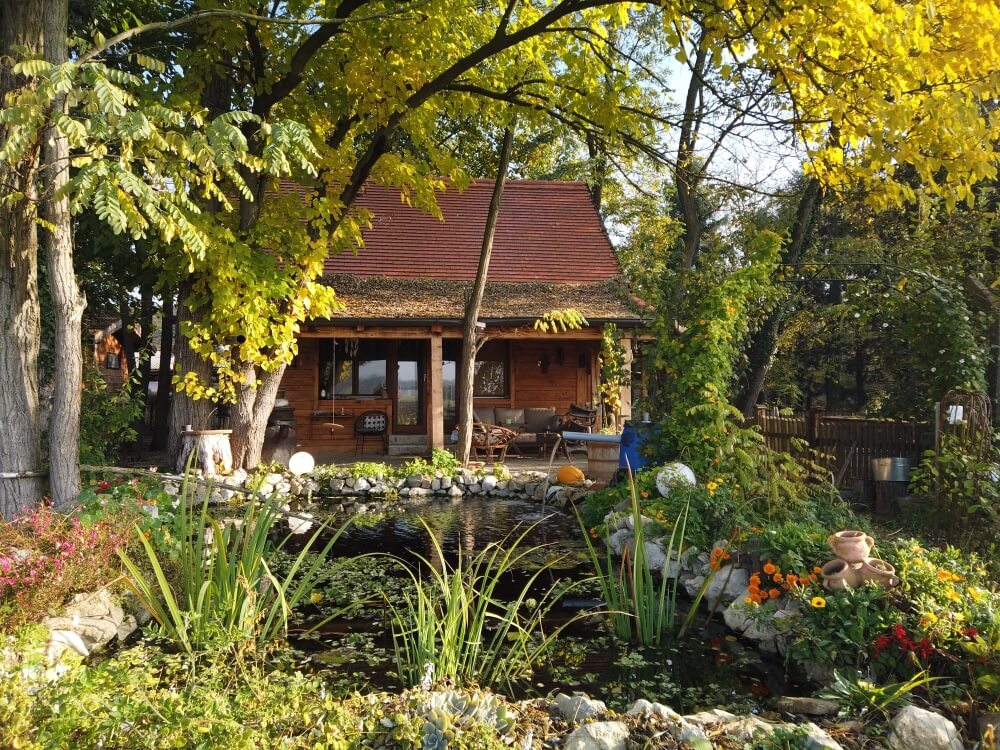 The impossibly pretty OPG Čudesna near Kopački rit Nature Park, Bilje Municipality, Baranja © OPG Čudesna šuma.
The impossibly pretty OPG Čudesna near Kopački rit Nature Park, Bilje Municipality, Baranja © OPG Čudesna šuma.
“Because of my job - first, travelling all around the world, then travelling Croatia - I did not even have much time to think about it, let alone do it,” says Mario. “But, then Corona came. Finally, I found myself at home. At last, I had time to work on my dream.”
OPG Čudesna šuma in the Month of Baranja Cooking (Mjesec baranjske kuhinje)
A group of 30 or so are Mario's guests today at OPG Čudesna šuma. They're here for a presentation of speciality cooking. It's the grand finale of the Month of Baranja Cooking (Mjesec baranjske kuhinje).
Over previous weeks, OPGs from all across the region have welcomed guests to try goulash, soups, stews, perklet and other traditional foods of the area. While visiting, they've been embraced by the beautiful landscape of Baranja. Not only have they discovered how this delightful, distinct cuisine tastes, but also they've learned exactly how it's prepared. However, they've evidently saved the best for last. On the menu today, river fish inventively cooked, accompanied by a riotous rainbow of seasonal vegetables.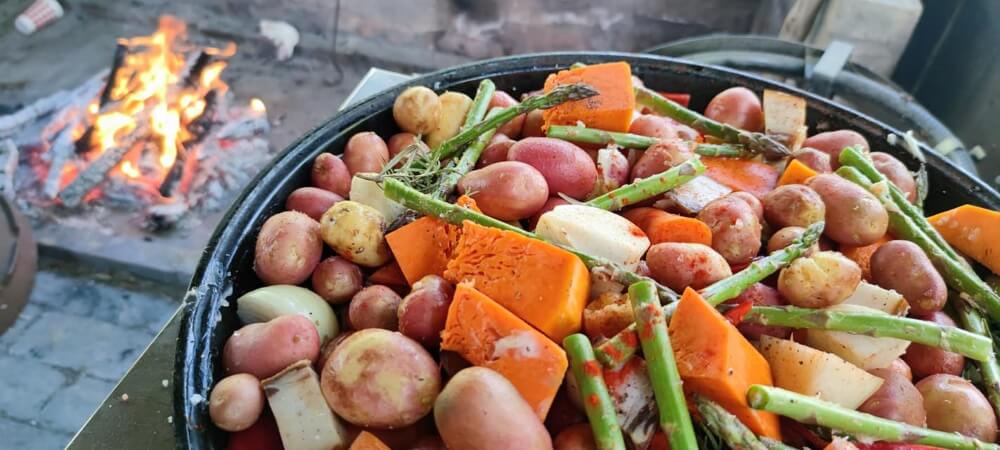 Seasonal vegetables of Baranja in springtime at the Month of Baranja Cooking (Mjesec baranjske kuhinje) © OPG Čudesna šuma.
Seasonal vegetables of Baranja in springtime at the Month of Baranja Cooking (Mjesec baranjske kuhinje) © OPG Čudesna šuma.
It's a beautifully sunny day, right at the start of May. It depends on your preference, but looking across this happy vista in the glorious sunshine, it's difficult to imagine this not being the perfect time to be in Baranja. Young children are raised to chest height by their parents so they can meet Mario's free-roaming llamas face-to-face. The children's faces flit between surprise, curiosity and delight. The llamas return their stare. They're used to welcoming new guests.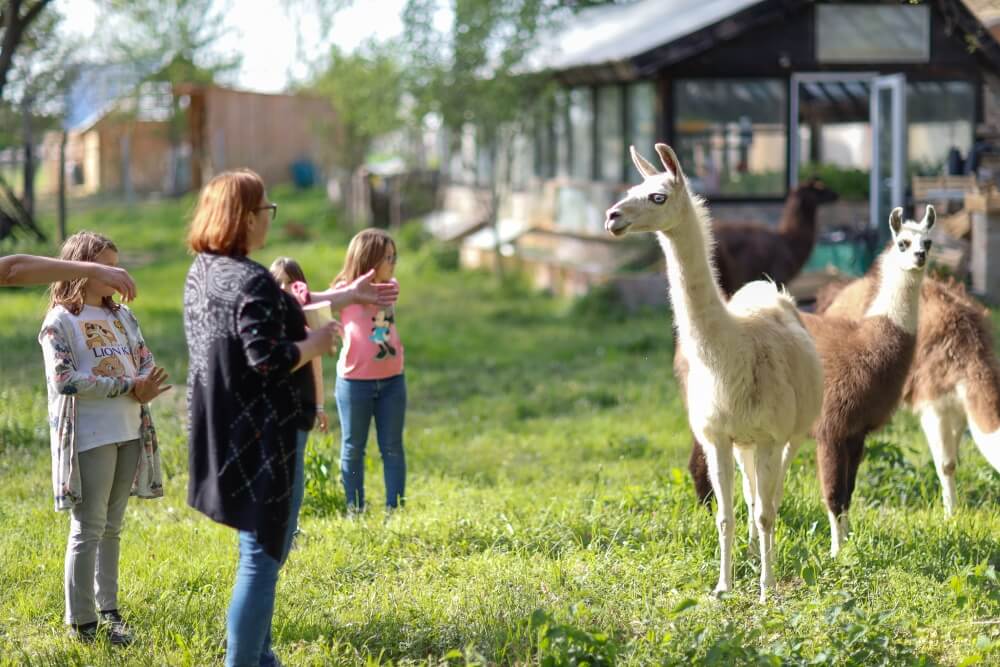 Meeting the Romulić family llamas at OPG Čudesna šuma © Turistička zajednica Općine Bilje - Kopački rit.
Meeting the Romulić family llamas at OPG Čudesna šuma © Turistička zajednica Općine Bilje - Kopački rit.
Partially shaded by trees, the smiling adult guests sit casually on wooden benches around a central, outdoor cooking area. Several open fires display a range of traditional cooking methods. Steam rises from a cast-iron stove suspended over one. Beneath the vapours, you can make out the dish is fish paprikash. It's unmistakable because of the deeply red coloured bubbles, a result of generous amounts of paprika.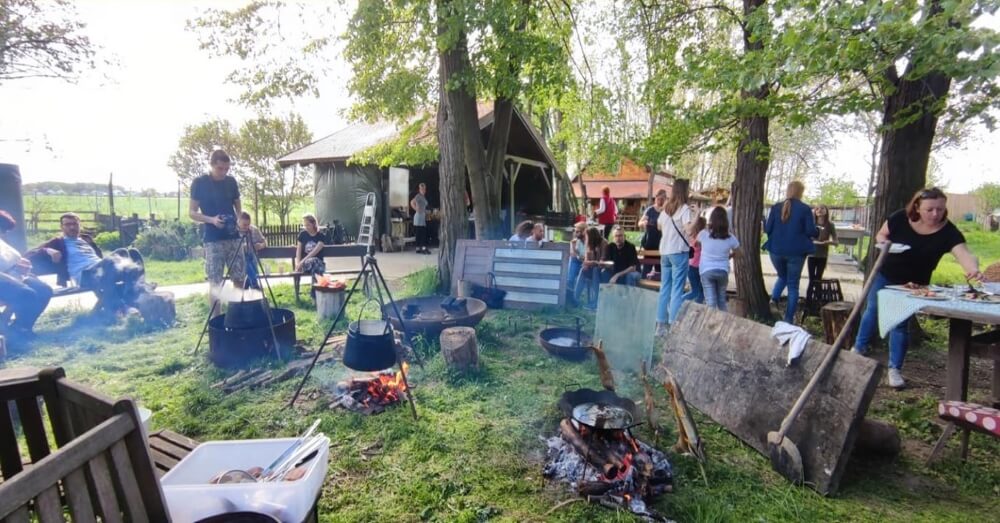 Guests enjoy a warm springtime day at OPG Čudesna šuma during the Month of Baranja Cooking (Mjesec baranjske kuhinje), as fish paprikas cooks over an open fire © OPG Čudesna šuma.
Guests enjoy a warm springtime day at OPG Čudesna šuma during the Month of Baranja Cooking (Mjesec baranjske kuhinje), as fish paprikas cooks over an open fire © OPG Čudesna šuma.
A huge bag of this paprika sits propped up, close by. It's from another organic OPG, just a kilometre or so from here. The colour is vivid, impossibly red, unrecognisable from anything store-bought. At the next fire, pike impaled on wooden sticks are placed far enough from the flickering flames so they cook slowly and do not burn.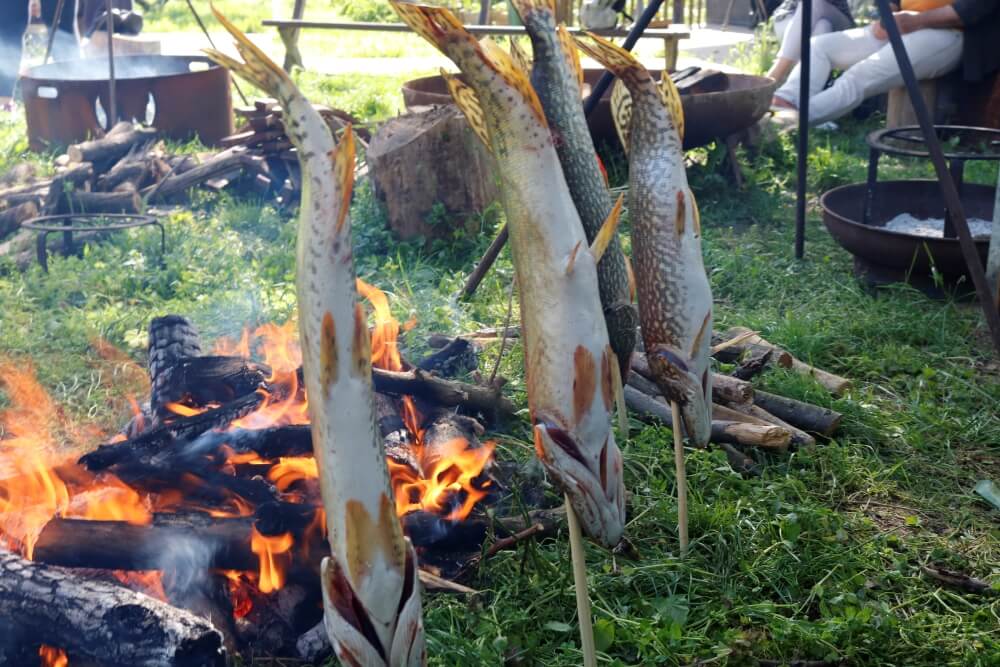 Pike impaled on sticks, cooking by an open fire at OPG Čudesna šuma @ Marc Rowlands.
Pike impaled on sticks, cooking by an open fire at OPG Čudesna šuma @ Marc Rowlands.
In the outdoor kitchen, Mario Romulić's co-chefs prepare an unending supply of fish dishes and vegetables. Carp, catfish, trout, bream. There's a bounty of fresh asparagus. It's that time of year. With the restraint of experience, they've cooked it perfectly. After the crunch of the bite, the flavour explodes. They're seasoned simply – delicious olive oil and sea salt.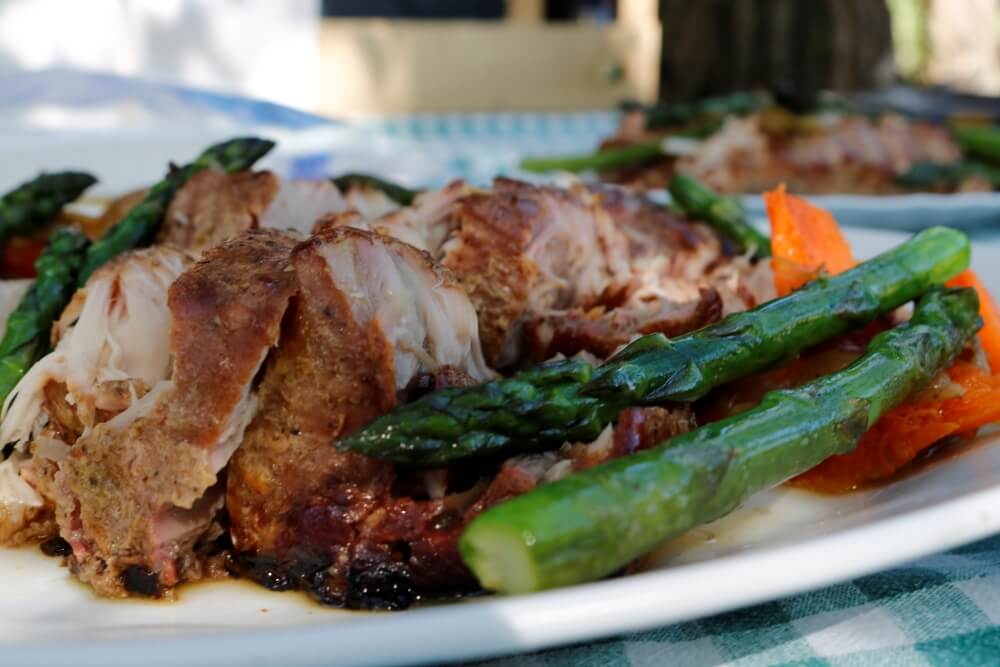 Seasonal asparagus, perfectly cooked, served with smoked river fish © Marc Rowlands.
Seasonal asparagus, perfectly cooked, served with smoked river fish © Marc Rowlands.
A group of peers – accomplished chefs from Osijek-Baranja restaurants – peak over the shoulders of Romulić's co-chefs. They're admiring the inventive techniques employed. Although, being chefs, they can't help themselves. They end up briefly forgetting their families in order to help out.
Mario Romulić, the host with the most
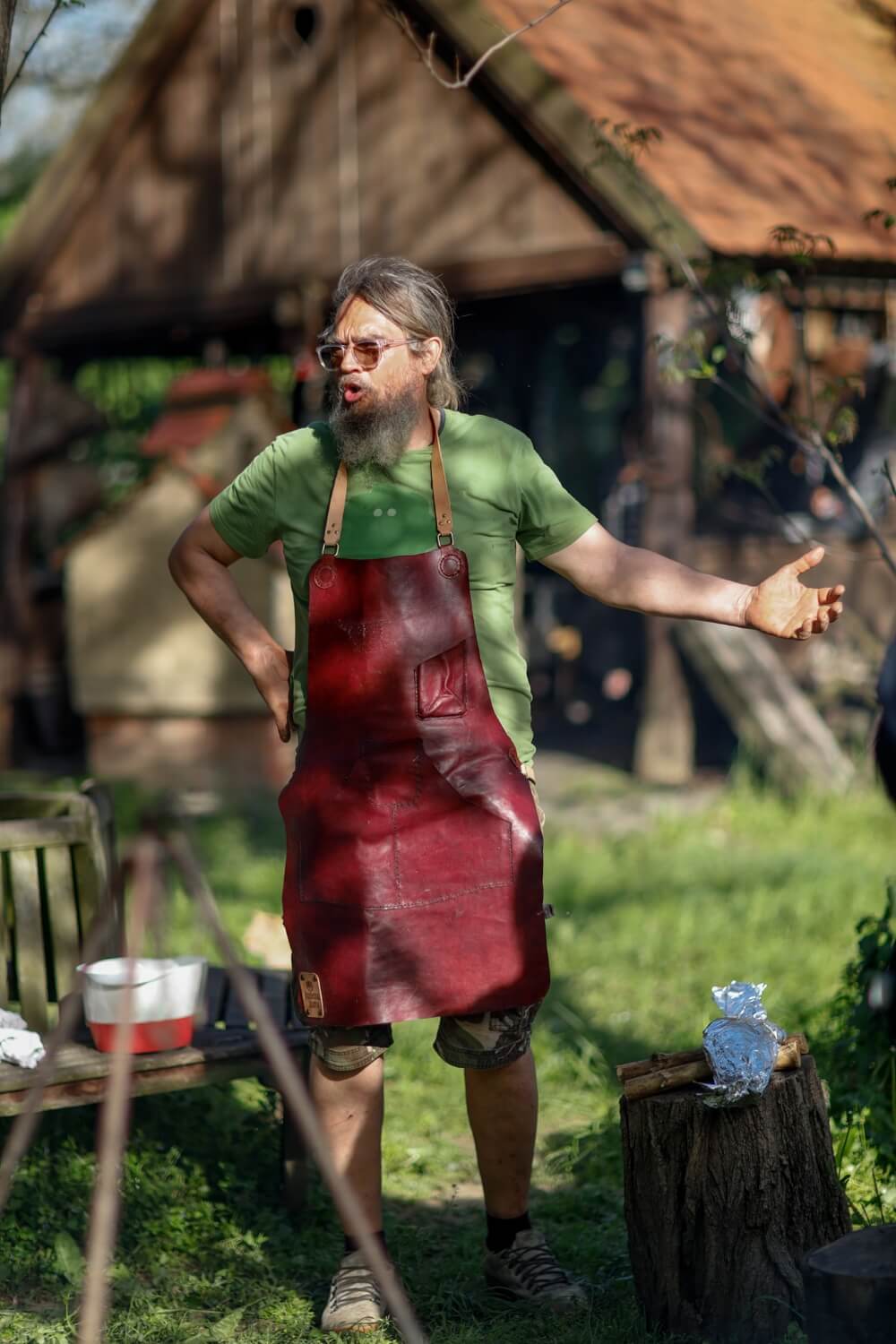 Mario Romulić © Turistička zajednica Općine Bilje - Kopački rit.
Mario Romulić © Turistička zajednica Općine Bilje - Kopački rit.
After all the guests arrive, Mario Romulić holds court. Cheerily he welcomes us all to OPG Čudesna šuma and the event. Without question, the success of rural, village tourism depends on the personalities of the hosts. It's no good plonking a group of visitors in a pretty place and throwing some food in front of them. We've all seen trees, grass and food before. Rural tourism is not just about the place, it's about the experience, the ambience. And, especially, it's about the people.
Hands down, the OPGs of Slavonia and Baranja are the best in Croatia at this. The folks here are famous for their friendliness, warm welcome and big personalities. And, Mario Romulić has one of the biggest of them all.
In the research for this reportage, looking back at archive pictures of Mario Romulić is startling. During his years spent as an international photographer, he himself has been photographed many times – on assignment in distant countries, at the opening of exhibitions that have showcased his celebrated work. In most, there's an intensity to his stare. It's sometimes difficult to look at. He looks like a man who has tales you never want to hear, like a man who has seen too much.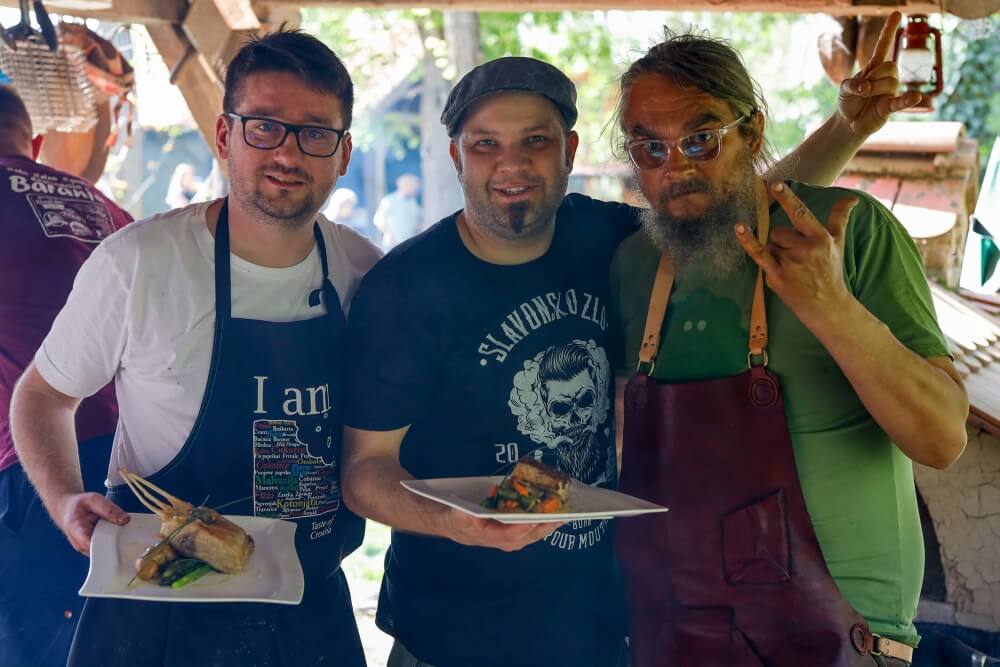 (L- R) OPG Čudesna šuma co-chef at the event Mihael Tomić, renowned Osijek chef Ivan Đukić currently of Osijek's Lipov Hlad and a happy Mario Romulić © Turistička zajednica Općine Bilje - Kopački rit.
(L- R) OPG Čudesna šuma co-chef at the event Mihael Tomić, renowned Osijek chef Ivan Đukić currently of Osijek's Lipov Hlad and a happy Mario Romulić © Turistička zajednica Općine Bilje - Kopački rit.
By comparison, the Mario Romulić that welcomes us at OPG Čudesna šuma today is unrecognisable. Sure, there's a little more grey to his long hair and beard but, otherwise, he looks incredibly healthy and happy. The intense stare is gone, replaced by a warm, wide smile that shows across his entire face. Even in early May, he has a darkened skin tone, the telltale signs of a man who spends much of the day outdoors. Romulić's enthusiasm for his guests and the event is palpable. After his sincere welcome, this enthusiasm is immediately transferred to each of his guests.
Mrs Romulić ensures everyone's glass is overflowing with wine or juice. One of Mario's teenage sons helps out with the food, while the other is taking photographs of the event. Well, someone has to do the photography now that dad wants to be a chef and host! Mario himself is engulfed in smoke. Among the other duties he's assumed today, Mario is tending a smoker. Without a doubt, this is the most revelatory cooking method we meet today.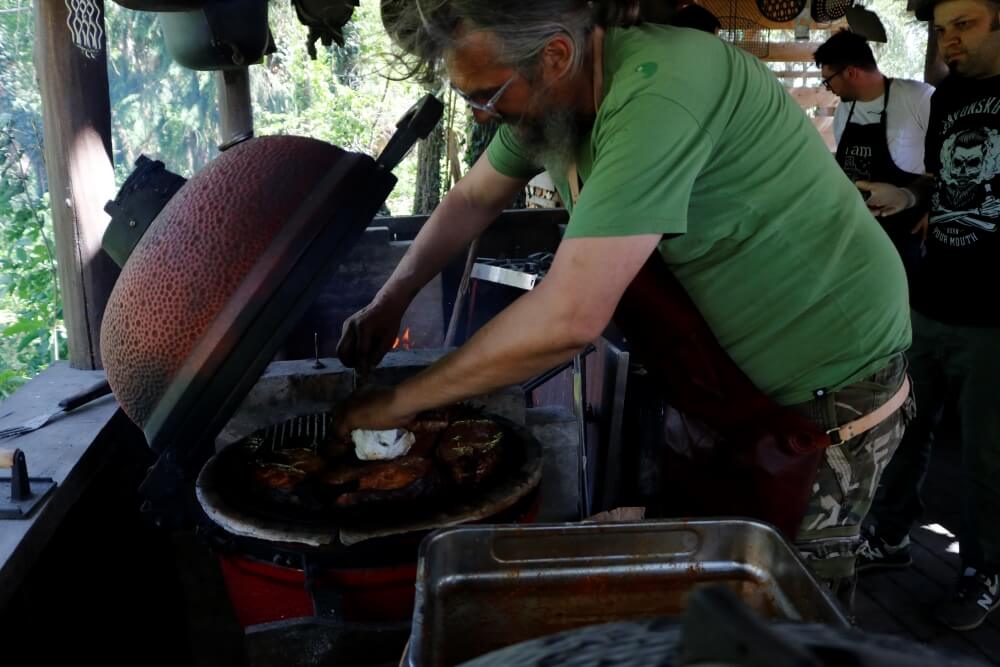 Mario Romulić tends to smoked river fish, a revelatory gastronomic experience at OPG Čudesna šuma © Marc Rowlands.
Mario Romulić tends to smoked river fish, a revelatory gastronomic experience at OPG Čudesna šuma © Marc Rowlands.
Smoked fish of Slavonia and Baranja at OPG Čudesna šuma
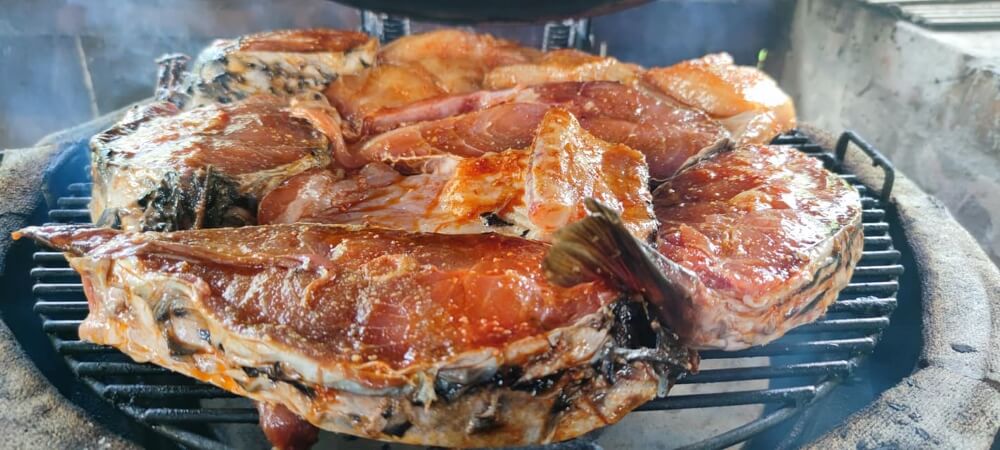 An American-style smoker, loaded with river fish. TOP TIP: A great way to stop fish sticking to the grill of your barbecue or smoker is to place them on top of a layer of lemon slices © OPG Čudesna šuma.
An American-style smoker, loaded with river fish. TOP TIP: A great way to stop fish sticking to the grill of your barbecue or smoker is to place them on top of a layer of lemon slices © OPG Čudesna šuma.
“We do have smoked fish here, but not in this way,” he says. “This is more like an American grill. I never heard of anyone trying Baranja cooking like this. Actually, I never heard of anyone nearby who has a smoker like this. The first time I tried stuka (pike) in the smoker, that was unbelievable. It's incomparable, really special.” Exquisite presentation of river fish by the enthusiastic team of OPG Čudesna šuma © Turistička zajednica Općine Bilje - Kopački rit.
Exquisite presentation of river fish by the enthusiastic team of OPG Čudesna šuma © Turistička zajednica Općine Bilje - Kopački rit.
“In Slavonia and Baranja, there are just a few ways we usually cook our river fish - carp on sticks, fish paprikash, perklet and fried fish. So, we tried something new, to expand the palette. For instance, almost nobody eats Babuška (a type of carp). They feed it instead to their pigs. It costs 5 kuna a kilo! But, if you cook it in this completely natural way, it's delicious.”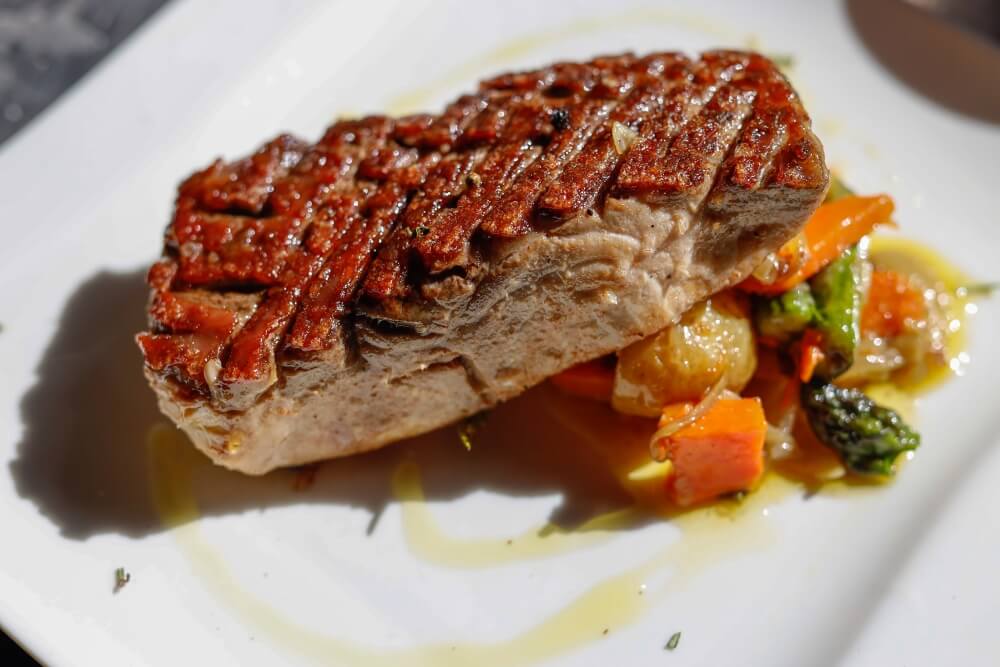 More river fish, cooked by the team of OPG Čudesna šuma © Turistička zajednica Općine Bilje - Kopački rit.
More river fish, cooked by the team of OPG Čudesna šuma © Turistička zajednica Općine Bilje - Kopački rit.
He's not wrong. Today's mountain of different smoked fish is the talk on most of the adult lips. The rich flavours surprise. Compliments and returns for second helpings ensue. Mario stands to one side, happily watching as his smoked fish secret escapes. In the future, he plans similar events based on other regional foods - Black Slavonian pig, wild meats like deer or boar. Eventually, in the seven hectares of land he owns here, he would like to expand OPG Čudesna šuma as an eco-village, with beds for visitors, a natural swimming pool and then surround it with a food forest. Big plans. It looks as though the camera may stay more permanently in the hands of his son. Because it's difficult to imagine Mario Romulić leaving his happy place and the realisation of his long-held dream.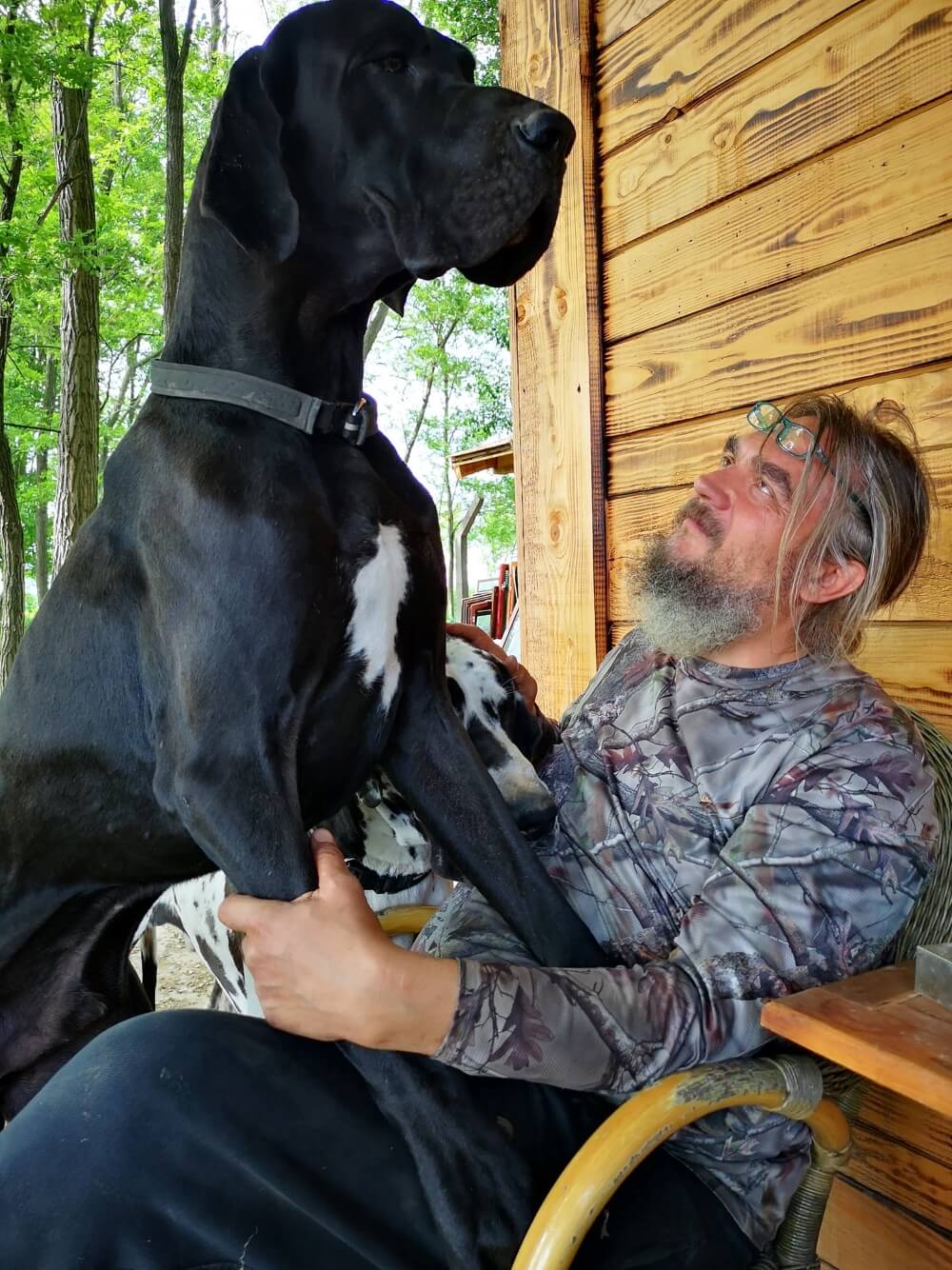 Mario Romulić in his happy place, with a friend © OPG Čudesna šuma.
Mario Romulić in his happy place, with a friend © OPG Čudesna šuma.
Both the author and Total Croatia News would like to thank the following for their invaluable help in creating this article: Ivana Jurić and the Tourist Board of Osijek-Baranja County, OPG Čudesna šuma, Mario Romulić and family, Renata Forjan and Turistička zajednica Općine Bilje - Kopački rit and Domagoj Butković of expert travel guides to Slavonia and Baranja, Kulen travel.
Slatina Sparkling Wine Find Makes Slavonia Champagne Among Croatia's Oldest
February 13, 2021 – A newly discovered, fully preserved bottle of 'Slavonia champagne' is unique evidence that Slatina sparkling wine is among the oldest in Croatia. Its fascinating history stretches back over 150 years
A completely preserved Slatina sparkling wine bottle from the period from 1864 to 1912 has been discovered during building works of Slatina's new visitor's centre. Found at a depth of two metres, the bottle is physical proof of what was previously known only from records – this 'Slavonia champagne' is among the oldest sparkling wine to have been made in Croatia.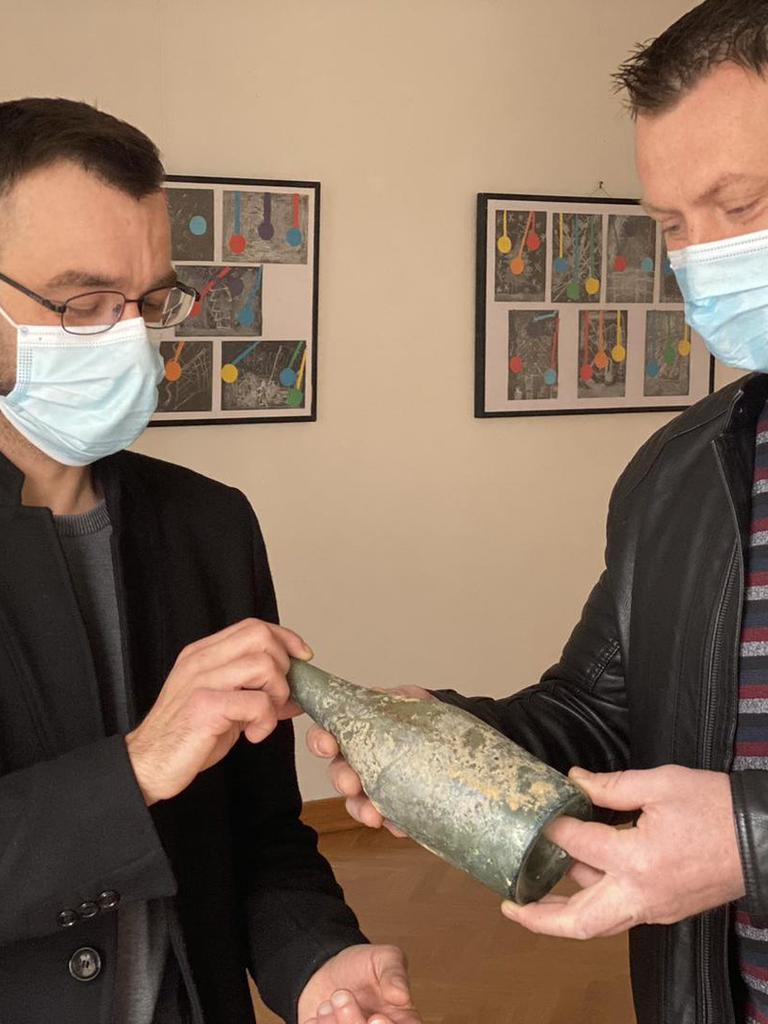 © Robert Turkalj
© Robert Turkalj
The discovery of the Slatina sparkling wine bottle is important to the city and its history. Other regions in Croatia have become extremely well regarded over recent years for their production of quality sparkling wines. The production of Slatina sparkling wine briefly disappeared during a period. But, this bottle is evidence that Slatina sparkling wine was among the first to be made in the country. It is the only fully preserved bottle of the 'Slavonia champagne' to exist in the region.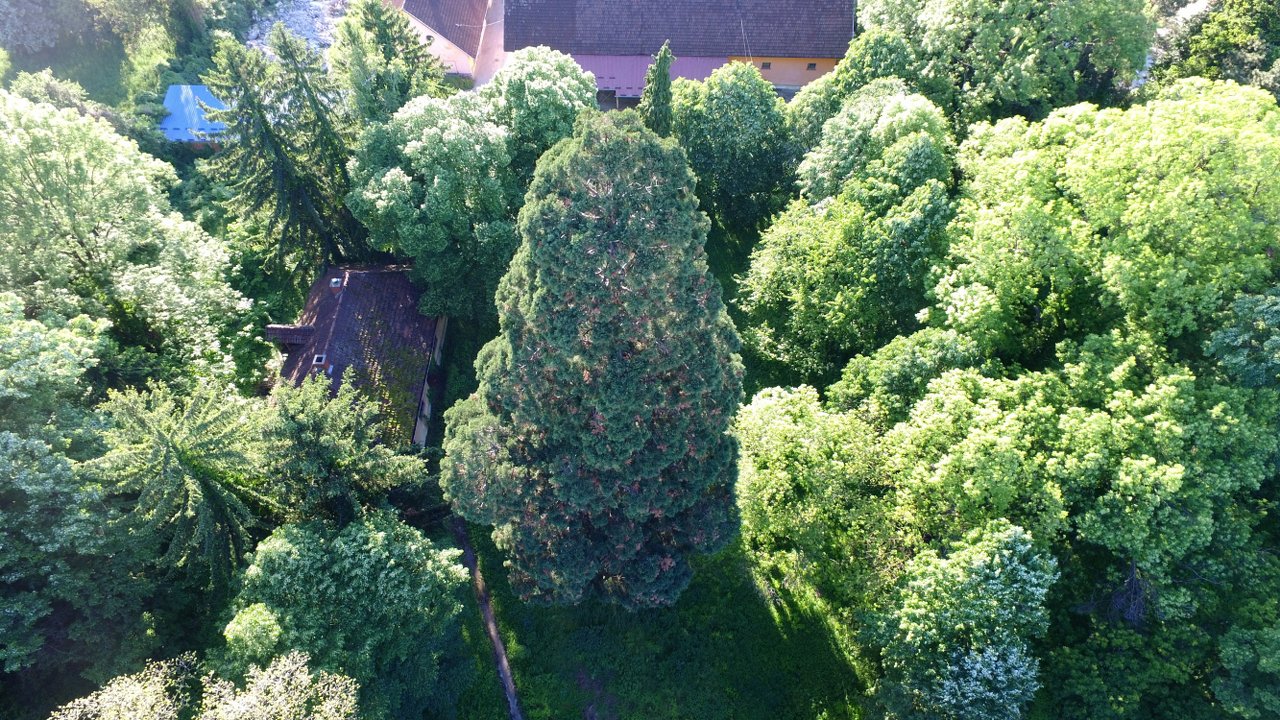 Slatina's nationally protected Giant Sequoia tree (Mamutovac) © Tourist Board of Slatina
Slatina's nationally protected Giant Sequoia tree (Mamutovac) © Tourist Board of Slatina
Of course, we can't really call it champagne – that title is reserved for a type of sparkling wine made in a distinct geographical region in France. But, there are great similarities between Slatina sparkling wine and champagne - similarities that do not exist exactly in other Croatian sparkling wines. Champagne is largely made from the Pinot Noir grape. The found bottle of Slatina sparkling wine was made from the Kadarka grape variety, which has been compared to Pinot Noir.
Both grape varieties are thin-skinned, delicate, easily susceptible to impairment and require a low yield to produce quality wines. Both are tricky to cultivate. For this reason, the Kadarka grape variety is now grown very rarely in Croatia, its place in vineyards taken by more hardy and some imported varietals. But, that wasn't always the case.
History of Slatina sparkling wine
In 1841, the German prince Georg Wilhelm Schaumburg-Lippe bought a property of land in the Slatina area from the Pejačević family. The land contained vineyards, orchards, agricultural fields and large forest areas, including the site of the new Slatina visitor centre where the bottle was discovered. Indeed, trees still line the road of Ulica kralj Zvonimir in the centre of Slatina – the cellar and restaurant of the town's famous Stari Podrum is just a few metres from Slatina's nationally protected Giant Sequoia tree (Mamutovac).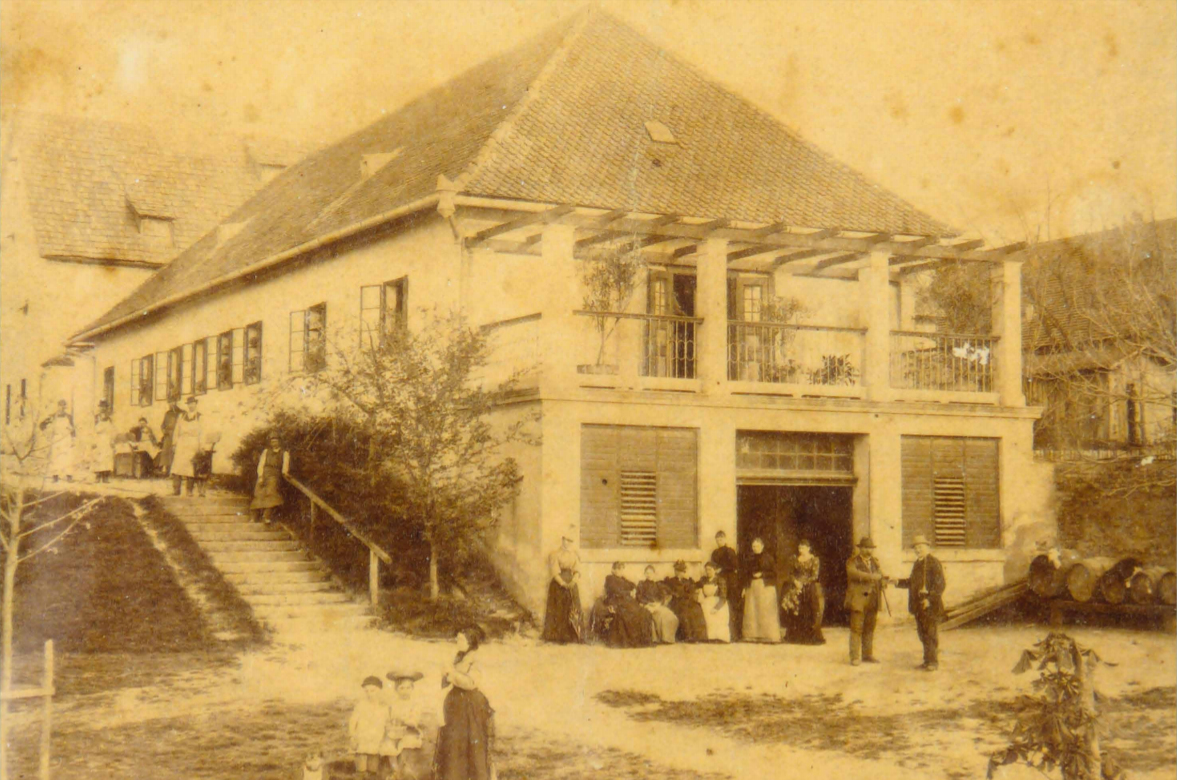 The Stari Podrum cellar, the site of the first-ever production of Croatian sparkling wine, at the beginning of the 20th century © Virovitica State Archives / Slatina Homeland Museum
The Stari Podrum cellar, the site of the first-ever production of Croatian sparkling wine, at the beginning of the 20th century © Virovitica State Archives / Slatina Homeland Museum
Slatina sparkling wine production started in 1864 at the Stari Podrum cellar, using the Kadarka grape variety. Perhaps it was the notorious difficulties of the growing the grape which resulted in slow initial progress for the production, but the enterprise got a massive boost in 1866 with the arrival of a new manager, Otto Rockhror. He rearranged the cellar and production, brought in new equipment and invested in marketing their Slatina sparkling wine. It worked.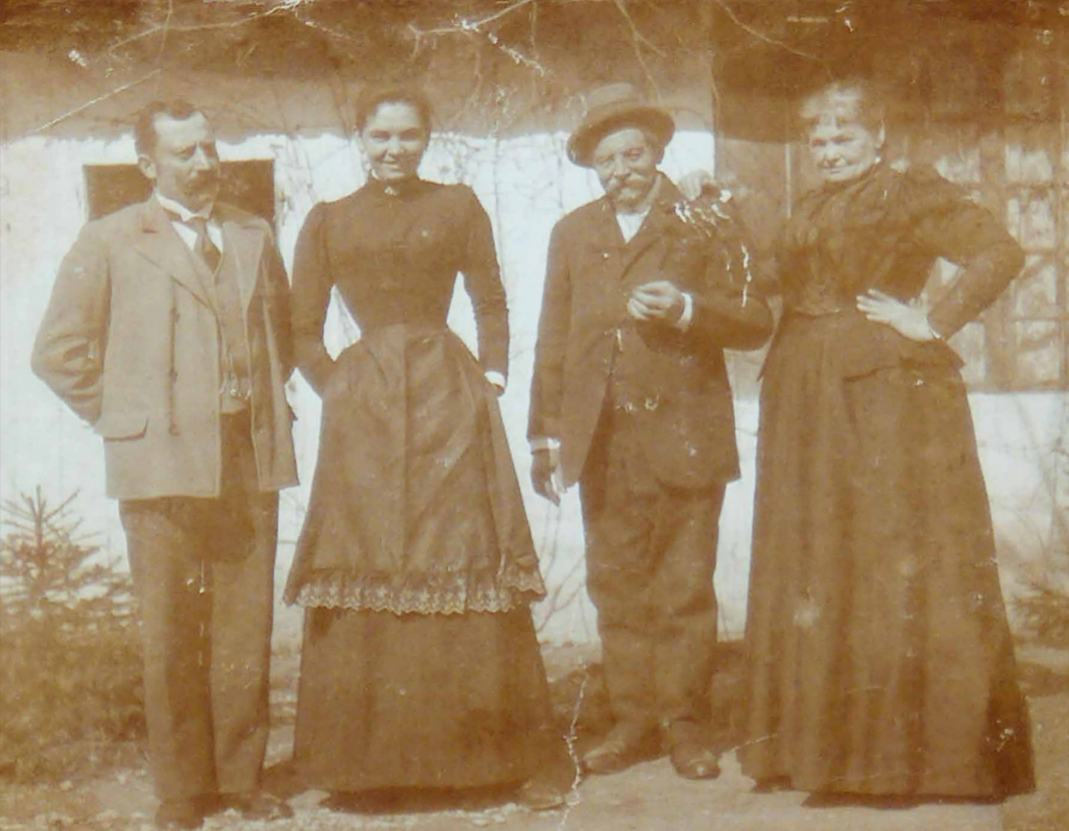 Left to right - Ljudevit Konstantinović, his wife Marija Konstantinović (the daughter of Otto Rockrohr), Otto Rockrohr and his wife Josefina Rockrohr © Virovitica State Archives / Slatina Homeland Museum
Left to right - Ljudevit Konstantinović, his wife Marija Konstantinović (the daughter of Otto Rockrohr), Otto Rockrohr and his wife Josefina Rockrohr © Virovitica State Archives / Slatina Homeland Museum
The quality of Slatina sparkling wine was recognized at the great Economic and Forestry Jubilee Exhibition in Zagreb in 1881 when Georg Wilhelm Schaumburg-Lippe received an honorary diploma and a large medal for domestic sparkling wine and fine wine. The credit perhaps lay elsewhere, considering it was the efforts of Otto Rockhror that were no doubt the cause, but, such were the times. However, Otto Rockhror's achievements with Slatina sparkling wine certainly did not go unnoticed.
At the Science and Industry Fair in Brussels, Belgium, in 1888, Otto Rockhror was awarded a bronze medal featuring the image of Leopold I. He received a further bronze medal with the image of Francis Joseph I in 1890 at the Agricultural and Forestry Exhibition in Vienna and was awarded a silver medal with the image of Franz Ferdinand in 1894 in Vienna by the Association for the Promotion of Agricultural Knowledge. These medals are on display in the Slatina Homeland Museum, donated by Otto Rockhror's great-granddaughter Jasna Nosso. They sit alongside a wooden barrel used in the production of Slatina sparkling wine from 1885 and, now, the latest testament to the history of Croatia's oldest sparkling wine production, the newly discovered bottle, which has been transferred to the museum for preservation, safekeeping and dating.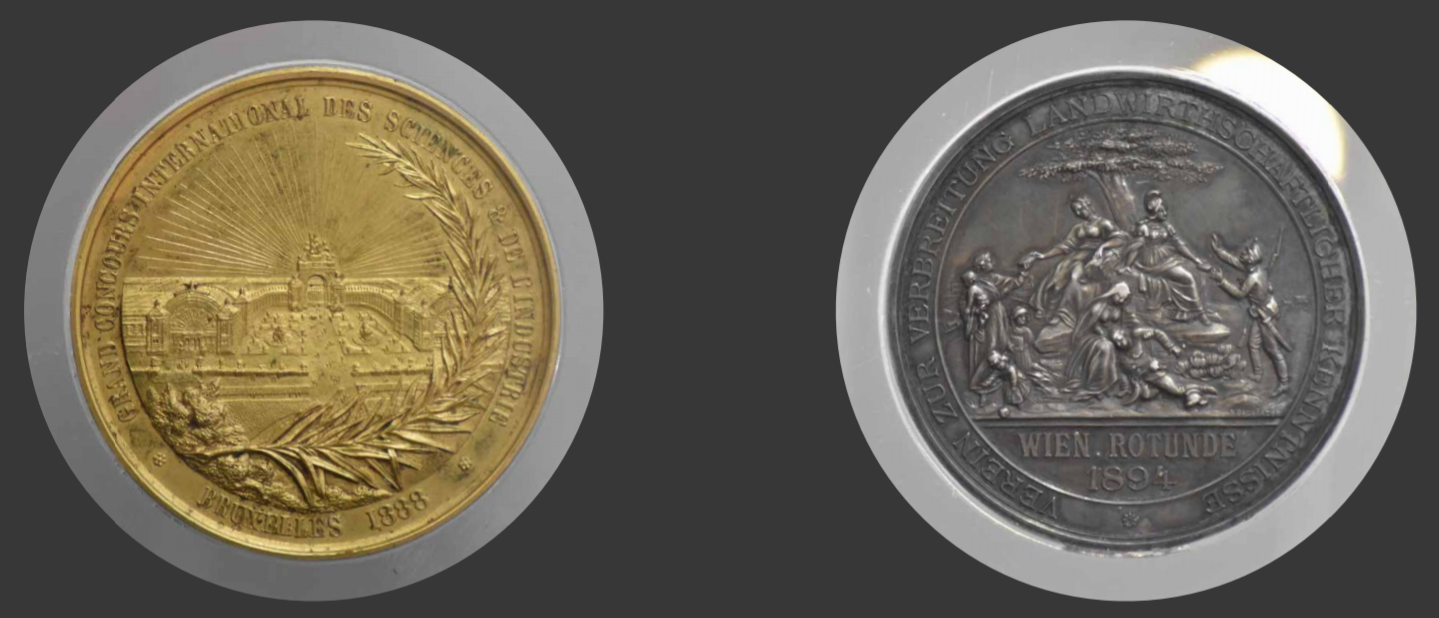 On the left, the bronze medal won by Otto Rockhror at the Science and Industry Fair in Brussels, Belgium, in 1888. On the right, the silver medal with the image of Franz Ferdinand he was awarded in 1894 in Vienna © Virovitica State Archives / Slatina Homeland Museum
On the left, the bronze medal won by Otto Rockhror at the Science and Industry Fair in Brussels, Belgium, in 1888. On the right, the silver medal with the image of Franz Ferdinand he was awarded in 1894 in Vienna © Virovitica State Archives / Slatina Homeland Museum
The production of Slatina sparkling wine from the Kadarka grape did not survive the loss of Stari Podrum cellar manager Otto Rockhror, who died in 1909. Thereafter, ownership of the enterprise was taken over by Count Drašković but, by 1912, production of Slatina sparkling wine had ceased completely and all the production equipment was moved to Hungary. Though the growing of the Kadarka grape variety almost completely died out in Croatia after this, it remains an important part of wine production in Hungary, Bulgaria, Romania and Serbia, where it is grown in Vojvodina, a landscape near-identical to that of Slavonia (indeed, though the heritage of the Kadarka grape is mysterious, the latest opinion is that it is a cross between the Turkish variety Papazkarasi and the Serbian variety Skadarsko and travelled to Pannonia with Serbs who fled north from the Ottomans).
However, the story of Slatina sparkling wine has not only been revived with the discovery of this old bottle. The Stari Podrum cellar still stands in the centre of Slatina today and vineyards still surround the town. The cellar and its wine production were bought by winemaker Ivan Halas over recent years and he has returned the production of Slatina sparkling wine to the historic birthplace of 'Slavonia champagne'. He has since received several awards for his efforts.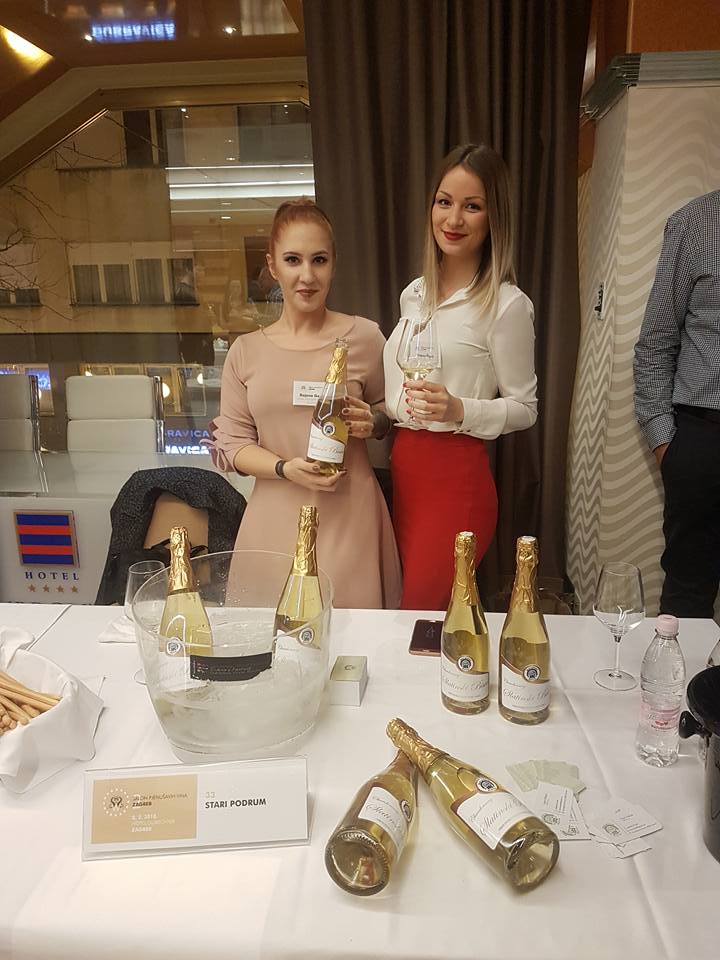 Slatina sparkling wine, revived by Ivan Halas at Stari Podrum, being presented at the 2nd Sparkling Wine Salon at the Hotel Dubrovnik in Zagreb © Tourist Board of Slatina
Slatina sparkling wine, revived by Ivan Halas at Stari Podrum, being presented at the 2nd Sparkling Wine Salon at the Hotel Dubrovnik in Zagreb © Tourist Board of Slatina
“As the Stari Podrum winery does not have adequate conditions for storing the found bottle, we took it to the Homeland Museum in Slatina where it will be stored,” Mr Halas told local news, upon the discovery of the bottle. “Only one bottle was found (so far), although there may be more. It is currently the only fully preserved one in the Slatina area. For now, we assume that it is from the period between 1864 and 1912 - we have no knowledge of the exact year, but the age of the bottle will be determined by experts.”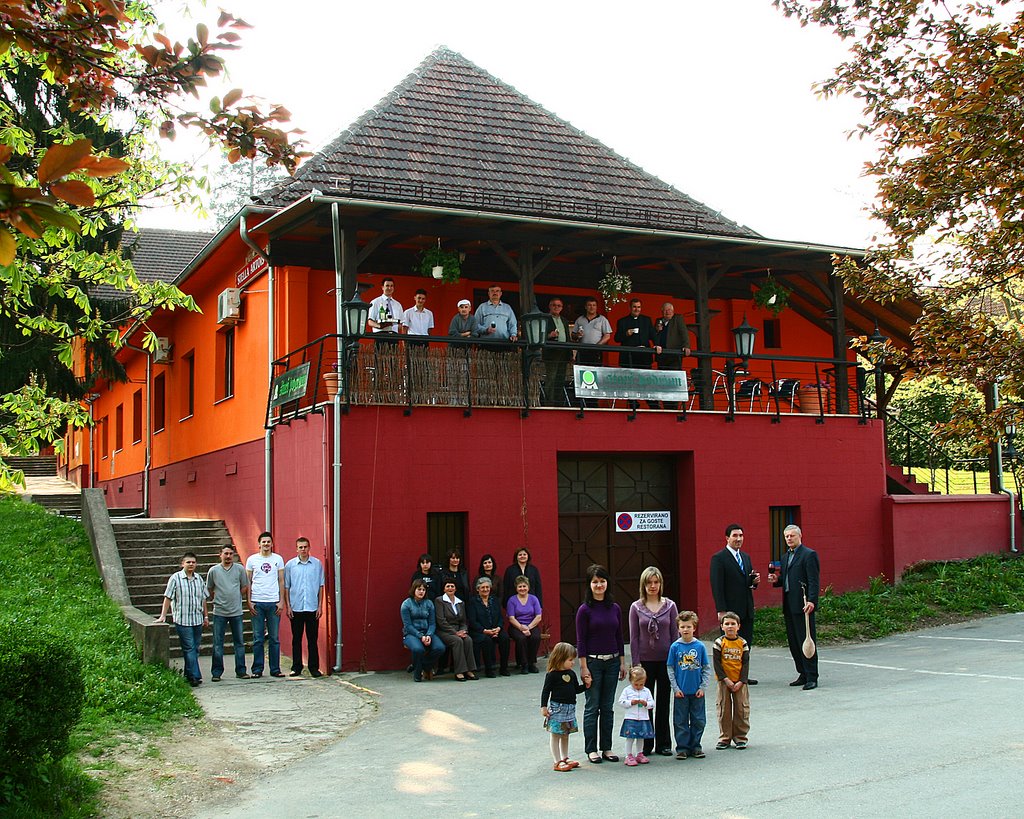 A more contemporary photo of the Stari Podrum enterprise in Slatina © Virovitica State Archives / Slatina Homeland Museum
A more contemporary photo of the Stari Podrum enterprise in Slatina © Virovitica State Archives / Slatina Homeland Museum


